Sound Explorations
Editor’s Letter
Opening Hearts and Minds Through Collaborative Composing
Classroom Culture
Dear Colleagues,

Sound Explorations
Editor’s Letter
Opening Hearts and Minds Through Collaborative Composing
Classroom Culture
Dear Colleagues,
We trust that the term has begun well for you.
The Editorial Team took the opportunity to review the publication after the milestone Arts Education Conference 2016 special issue. We believe that STAR-Post (Music) is a useful companion in music teaching for our teachers, and we are pleased to share with you its refreshed concept!
Pedagogy is powerful. For example: how a song is taught can deeply impact the way it is learnt and experienced by students, and by implication, how much they would enjoy, and the extent to which they would understand the music. The process of teaching and learning can make or break the lesson. Pedagogy is a key that unlocks the joy of learning
What does good music teaching look like?
Within this STAR-Post (Music), our fraternity has contributed a curated discourse of Play in Sound: what good teaching practices look like for our classrooms, and in our classrooms. We draw perspectives from pedagogues, as well as pedagogical thinking and strategies from our colleagues in the fraternity.
We invite you to join us in the imaginative world of sonic play!
As renowned music educator John Paynter puts it,
‘the basic resources of music are sounds and silences’ 1 .
Indeed, playing in sound (and silences), exploring different ways of play, form the basis of music creating and improvising. This issue shares how pedagogies offer a myriad of first-hand music experiences for students as creators and inquirers, building their confidence and creative potential.
We first hear from STAR’s OEIR Paul Griffiths, who encouraged collaborative play between teacher and students while valuing their musical voice. We also get much inspiration from our STAR Champions who shared various creating and improvising strategies in our latest STAR Publication, Sound Explorations. Another kind of musical play is revealed through stories. As part of our Engaging with Songs Programme, OEIRs Kate Woolveridge and Rinat Gilat Efron illustrate to great effect, how creative storytelling can inject meaning in music learning. Our Music Senior Teacher, Ms Ng Kay Gek, also shares how she plays through singing games in her music lessons.
This issue also introduces the newly launched Singapore Teaching Practice (STP). The STP is a model that makes explicit how effective teaching and learning is achieved in Singapore schools. Over the next few issues, STAR-Post will unpack how effective teaching and learning look like in the music classroom.
We hope you enjoy the read!
Ho Hui Ping Deputy Director, Music
Singapore Teachers’ Academy for the
aRts
in education, pp 9 – 14. Oxford University Press. Extracted from writing by Paynter published in Music in Education (1967).
STAR was privileged to host our Outstanding Educator in Residence (OEIR) Mr Paul Griffiths, an international renowned educationalist and musician who is currently teaching at the Guildhall School of Music and Drama (GSMD).
Bringing three decades of experience in facilitating creative and collaborative music making with conservatories, professional arts organisations and community groups worldwide, Paul conducted a series of spirited and thought-provoking workshops for primary and secondary music teachers on using the Non-formal teaching approach to facilitate collaborative composing in the Music classroom.
The Non-formal approach focusses on providing an open environment where students are invited to contribute their personal musical ideas, and to collaborate with one another to weave their diverse ideas into a common musical tapestry. Students therefore have an active hand in shaping the form of the music. This is in contrast to strictly “formalised” teaching methods, where a teacher delivers a pre-determined lesson delivery to students who are expected to respond in a prescribed manner.

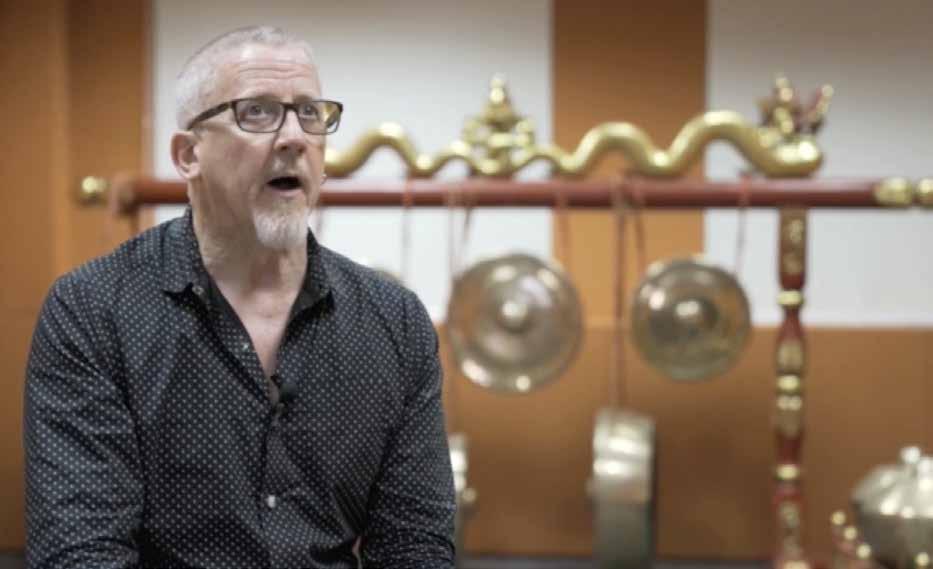
Click here!
While the term “non-formal” may suggest a casual or arbitrary manner, Paul’s workshops are anything but. Each session was characterised by a high degree of concentration and inventiveness on the part of the teachers, all under Paul’s sensitive and skilful guidance.
The workshops with Paul surfaced three vital principles for facilitating collaborative composing:
i. Engendering a responsive and dynamic creating process;
ii. Creating a safe space for the student’s musical voice; and
iii. Building the musicking skills of the teacherfacilitator.
Engendering a responsive and dynamic creating process
What Paul establishes foremost is that music comes from a deliberate act of creating, and never a passive mimicking of prescribed and static notes. And indeed, creating was implicit in every workshop activity, right from the warm-ups. On top of a guitar ostinato or drum groove, participants were invited to layer their self-created melodies. Whenever a participant introduced a new element that steered the music in an unexpected direction. Paul would then respond to this change by modifying his ostinato to usher the music into the next phase of improvisation.
The focus is on inventing a musical idea, listening to its effect and making adjustments so that everyone’s ideas interact more congruently with one another.
When music making is no longer tied down to a rigid format, students are free to imagine dynamic new trajectories for the music to take flight. Everyone is kept in suspended anticipation wondering what might happen next, and what response he/she should make. Even doing nothing affects the outcome, so disengagement is never an option.
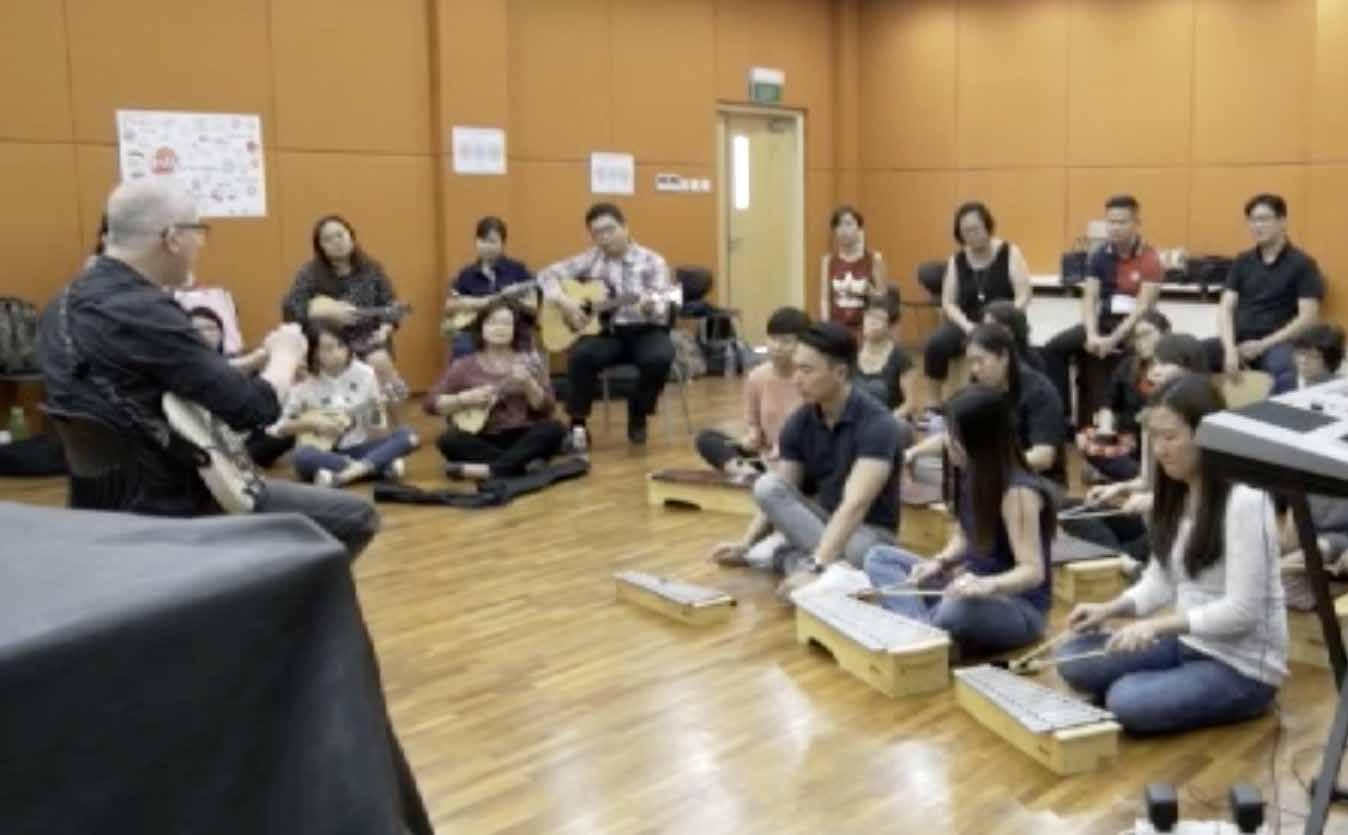
Paul’s belief is that everyone can create music.
To begin, he customises the musical parameters, and scaffolds each task to match the ability level of his participants. For the novice, Paul might offer a limited range of notes to freely experiment with, using various rhythmic and sequential permutations.
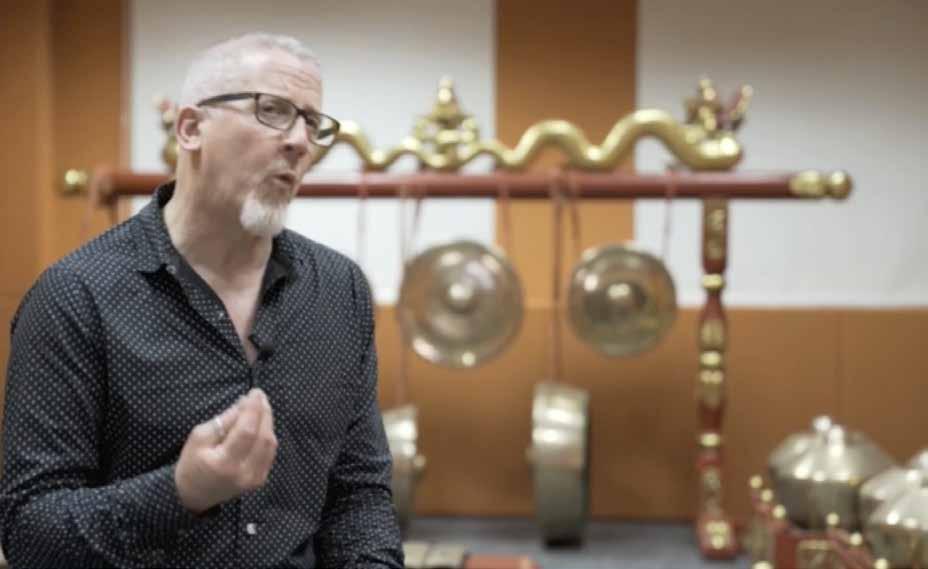
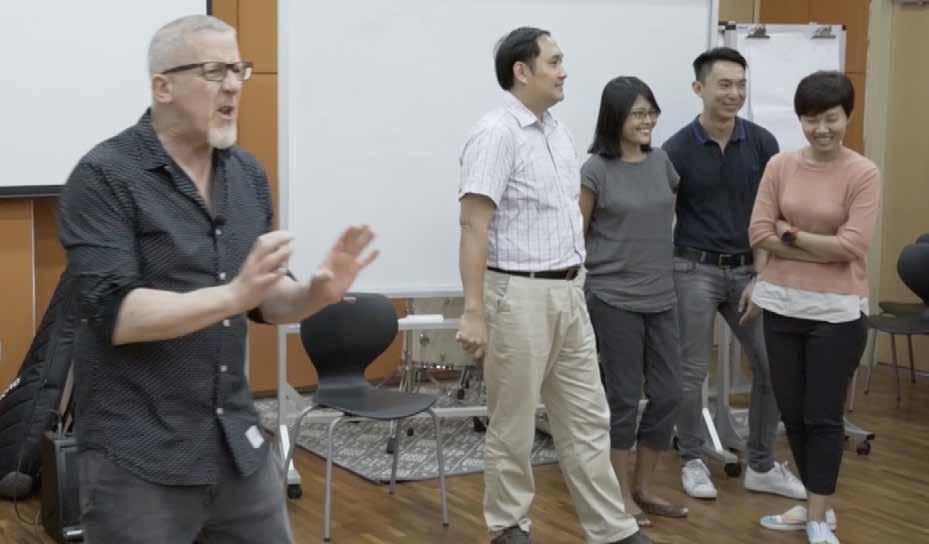
Giving students opportunities to voice their ideas opens infinite musical possibilities. To curate these ideas into a grand symphony, music teachers require an extensive toolbox of strategies, including rhythms, textures and styles to best complement various improvisatory scenarios.
As the participants get more proficient, Paul opens other parameters for manipulation, while calibrating his instructions such that the music never descends into chaos or cacophony. Through the process of improvising, the participant learns first-hand the intriguing effects of varying rhythm, texture, dynamics and register.
Paul cleverly builds on the participants’ sounds and weaves them into a composition, thereby valuing and drawing out each person’s musical voice by providing a safe space that fosters courage and confidence to experiment without fear of failure.
The non-formal approach reframes the classic role of the teacher, where the teacher now becomes both listener and learner - attending carefully to what the student has to say
As such, Paul emphasises the critical importance for music teachers to cultivate their musicianship to the highest level possible. The music teacher should continue to engage in music practice to constantly update, broaden and deepen his/her familiarity with different musical styles.
Paul does not believe there is any dividing line between an excellent musician and an excellent teacher. He himself is a consummate professional Jazz guitarist. His wide-ranging musical experiences have allowed him to build his acumen as a teacher. The challenge is for music teachers to work toward being the best musician they can possibly be.
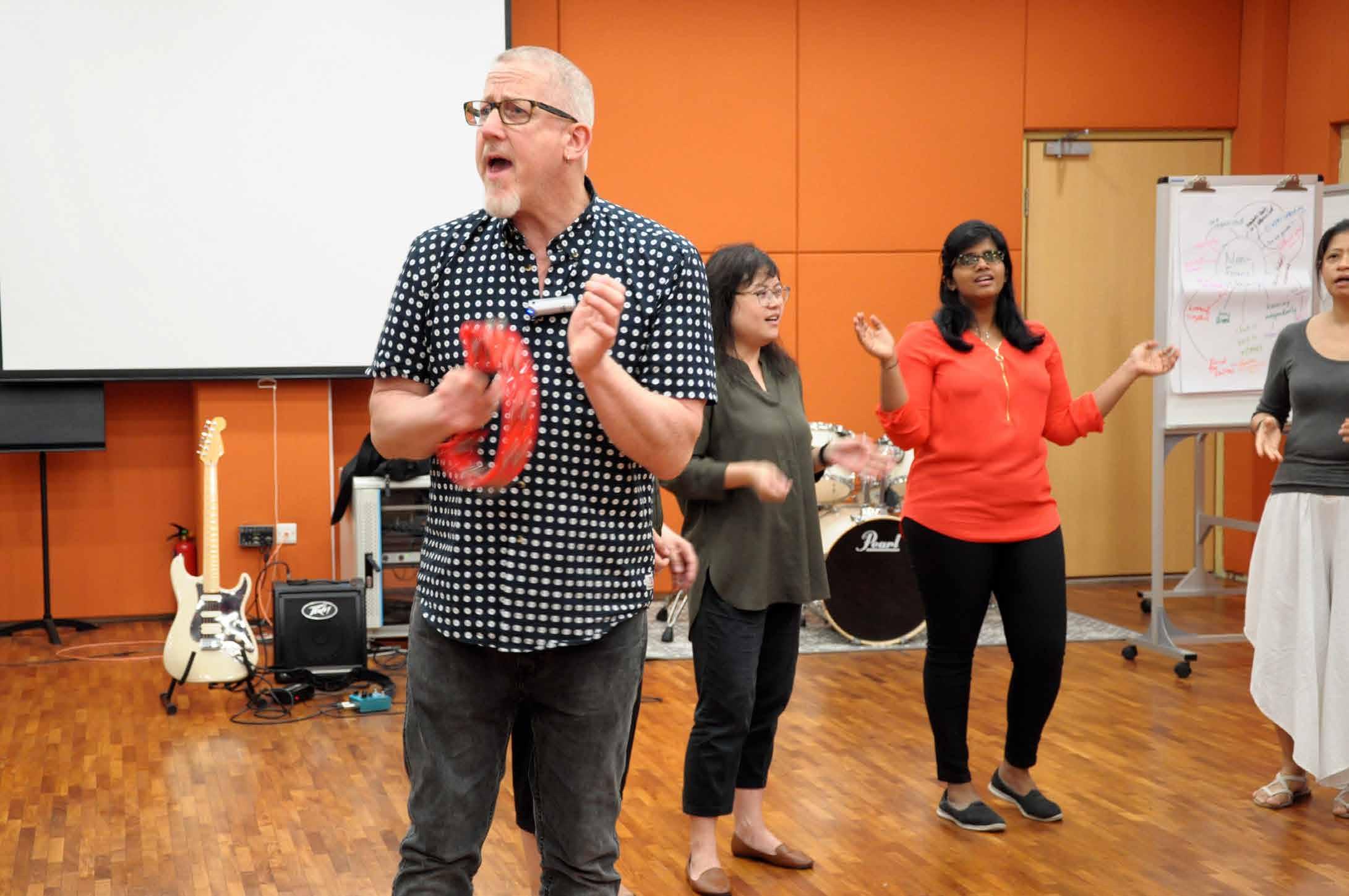
Paul Griffiths musicking with teachers
Paul shared about a young boy he met twenty years ago at a community music-making workshop. The boy was uncooperative and disengaged, and made it obvious he had no desire to participate. Paul persisted in encouraging him to engage in music making, leading to his participation in subsequent community music projects. As a result, he flourished as a musician through the years, and is today a successful professional percussionist in the UK, whom Paul continues to perform with. Music transforms people.
The underlying message in Paul’s sessions is that music making is a direct expression of human community, as has long been practiced in musical traditions across the world. Each person must be confident to voice his/her own ideas, and yet be receptive to feedback to build a harmonious narrative together. The non-formal teaching approach in improvisation and composition therefore reinforces and celebrates importance of music making as a community.
“Composing will always be a memory of inspiration; improvising is live inspiration, something happening at that very moment. Do not fear mistakes. There are none.”
– Miles Davis
Often, we hear from music teachers that composing and improvising can only take place when students can read notation, and that they are already musically accomplished, and well-trained in music theory.
Using language learning as an analogy – novice learners (think toddlers) of a language often listen and speak first before they learn to read and write. Similarly, the sounds and experiences of creating and improvising naturally come before the signs and symbols.
In fact, the starting points of creating, composing and improvising has not much to do with the amount of music theory one has acquired. Sometimes, that can be more a hindrance than help.
The process of creation begins with explorations. The stimulus could be text, a sight, a sound, a smell even, to trigger our imagination and translate it into sounds. This discovery process, however small, sparks the first steps to improvisation.
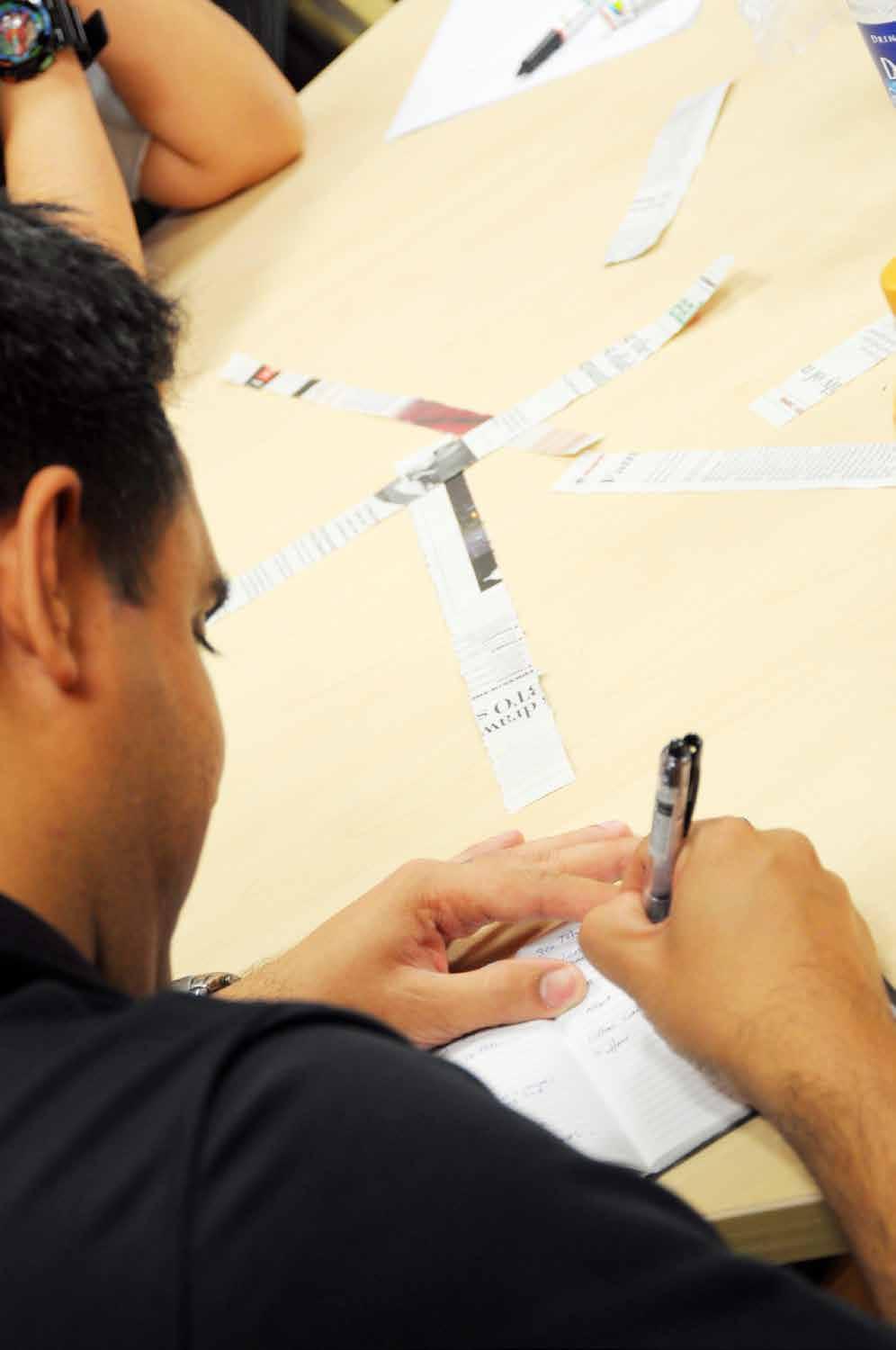
The STAR Champions (Sec) started their journey of sound explorations at the STAR Champions workshop held in February led by Mrs Tan-Chua Siew Ling, Master Teacher (Music). The intent of which was to broaden the perspectives of what composing and improvising are about, and to tap on the sonic potential of varied stimuli ranging from daily objects such as newspapers, instruments to technological apps, to encourage experiential play of sounds leading to musical composition.
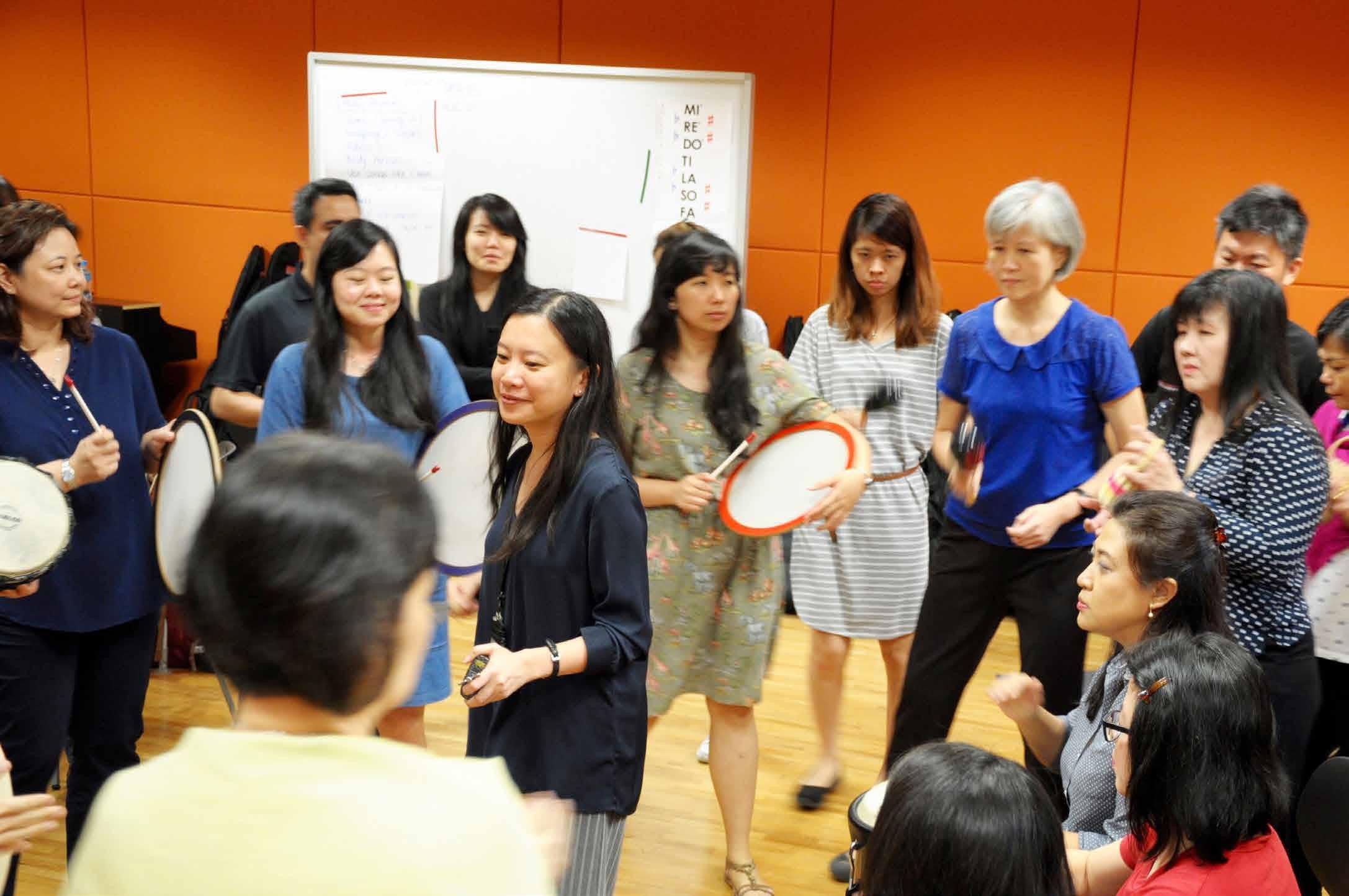
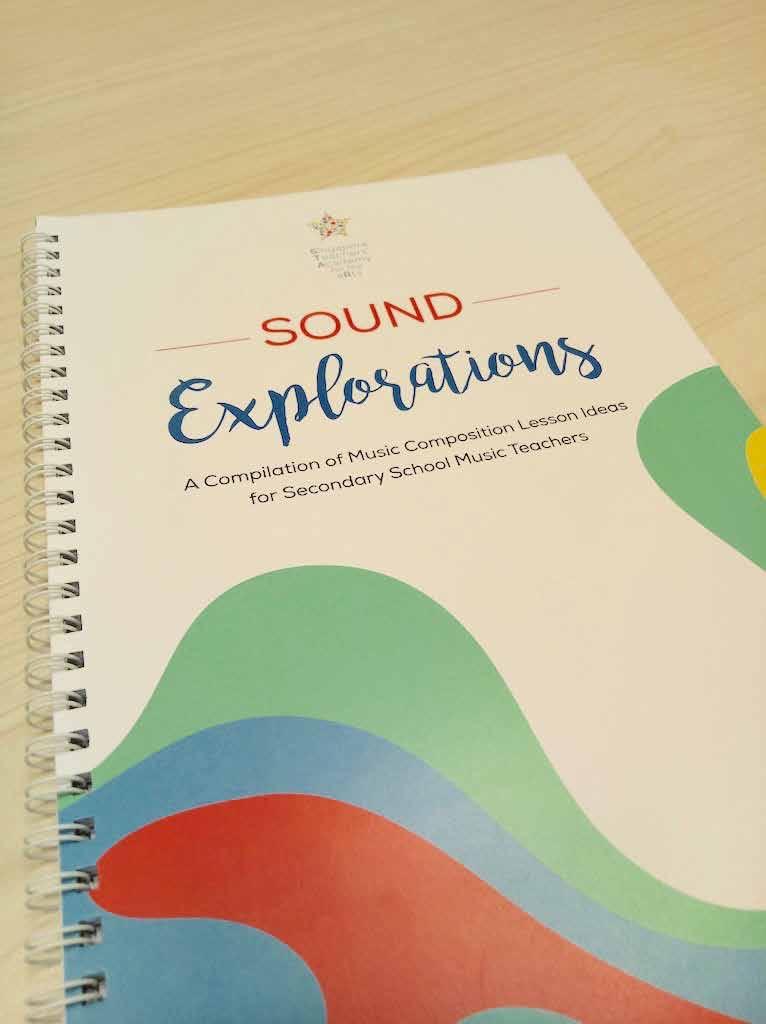
Our STAR champions went on to trial their music composition ideas in their own classrooms leading to the compilation of compositional lesson ideas entitled Sound Explorations. One lesson adapted from using a newspaper manuscript was by Ms Tan Cijun Eudora.
The students’ understanding of dynamics, pitch, tempo and texture is first scaffolded by analysing Potter Puppet Pals: The Mysterious Ticking Noise. Building on this understanding of music elements without the need for notation, the students work in their groups to experiment with ways to read a given newspaper manuscript bearing in mind the need for contrast. The collaborative nature of this composition lesson allows each student to contribute their ideas regardless of musical ability. This, in addition to the students’ peer-critique of their classmates’ work, makes for a student-centric lesson.
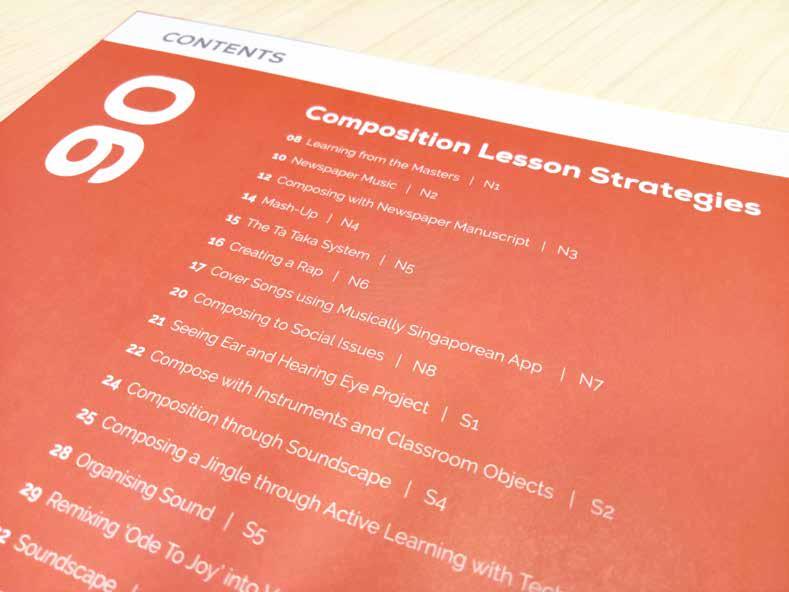
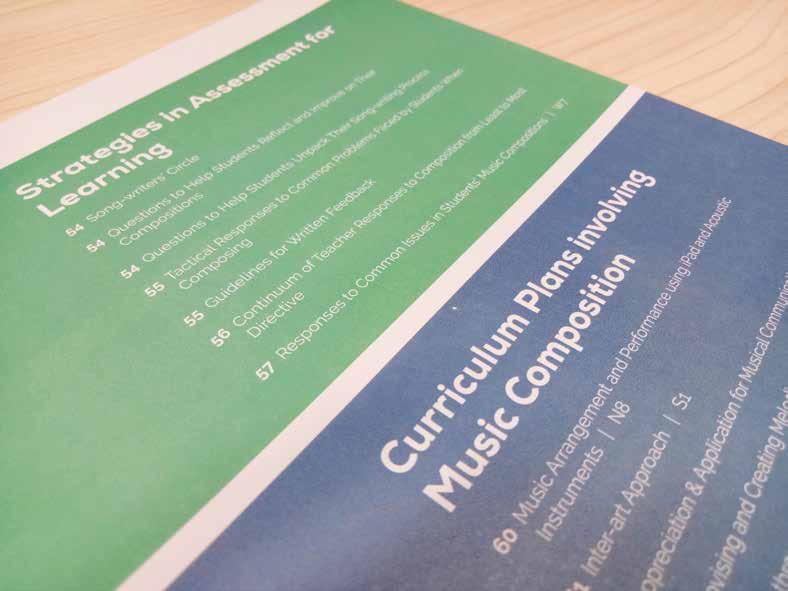
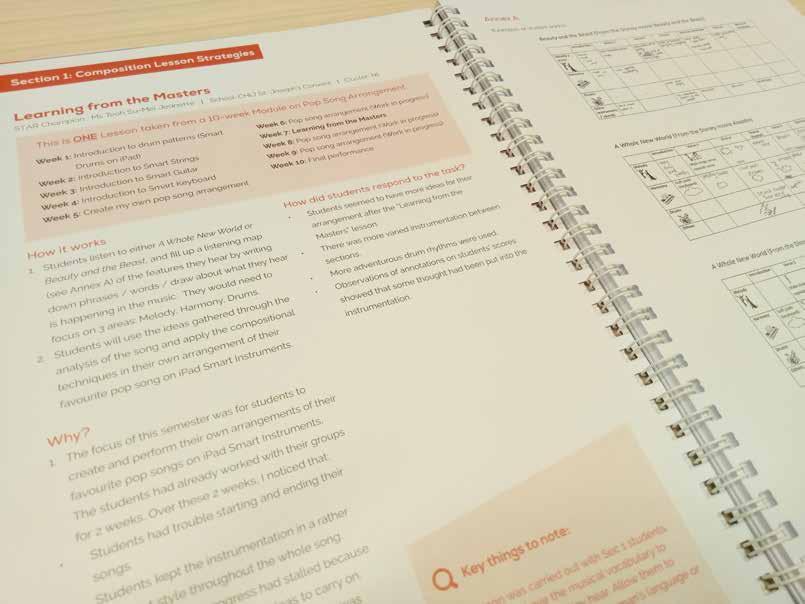
Sound Explorations – A compilation of music composition lesson ideas for secondary school music teachers
Click here to view STAR Pedological Resources!
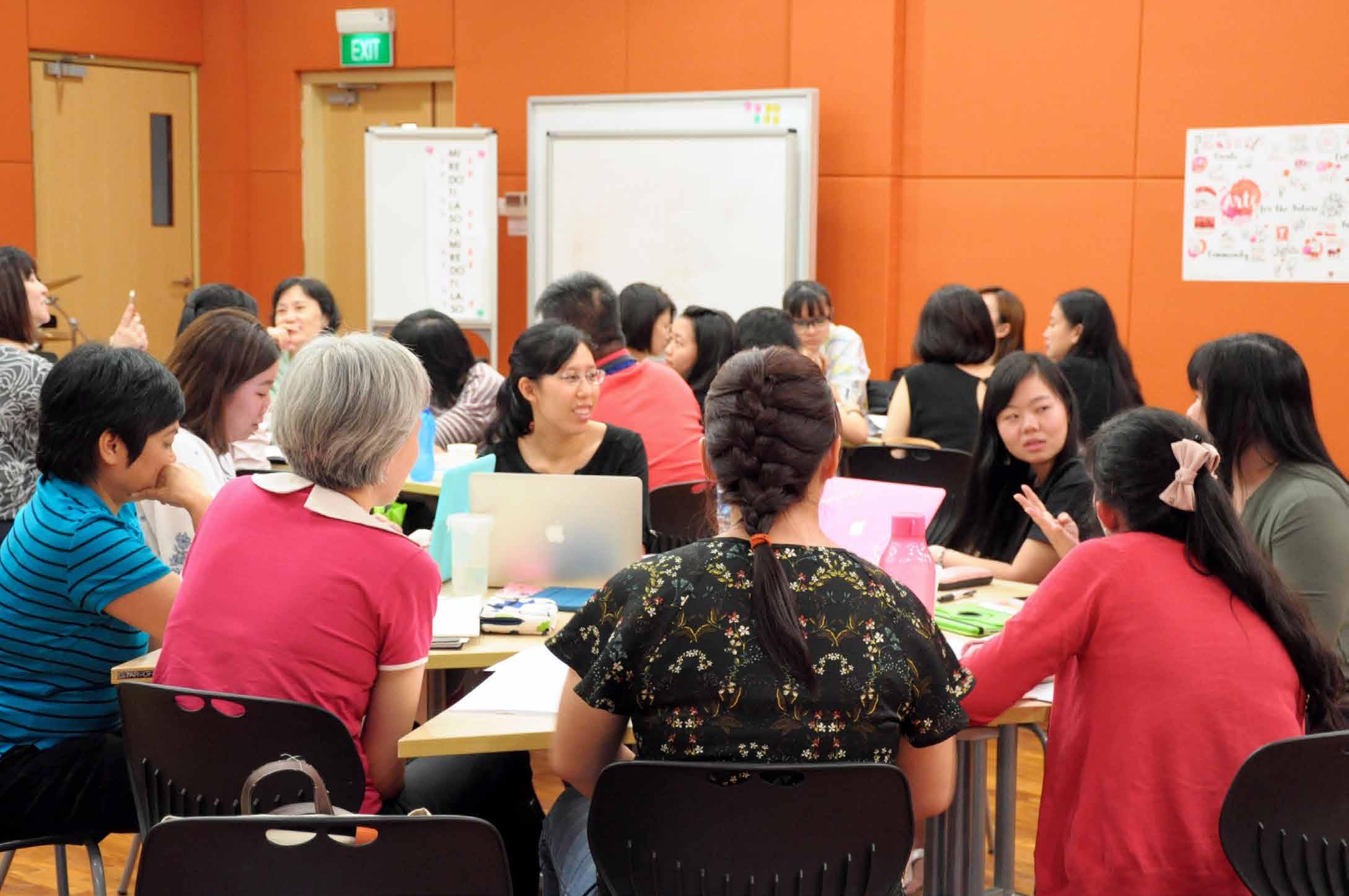
The activities mentioned in the lesson resource book provided me with more ideas that expanded my pool of lesson strategies.
Ms Lim Hui Wen Jwen
Co-ordinator Woodgrove Secondary School
In detailing the lesson ideas for the Lesson Resource book, N1 STAR Champion, Ms Jeanette Teoh expressed that
Talking through our lesson ideas with the team of STAR Champions helped clarify (our pedagogical thinking) and made clear the learning objectives the lessons were intended to achieve.

Creating a musical composition can be an enjoyable experience for everyone. The STAR Champions (Pri) went through a process of collaborative musical exploration, facilitated by Mrs Li Yen See, Master Teacher (Music), to understand and appreciate that improvisation and composition lie on a continuum of creating.
To help make students’ musical improvisation visible, one could consider a thinking routine, Colour-Symbol-Image, to tap on the teachers’ creativity and desire for expression, allowed multiple interpretations and connections to develop their metaphorical thinking.
When shared during the STAR Champions workshops, they generated four contrasting moods based on a chosen Colour. An exploration of musical motifs through use of pitched and unpitched instruments ensued to depict the moods. Then, they articulated the possible Symbols that represent their musical motifs. These musical motifs were further explored and expanded upon stitching all these Symbols into a collectively drawn Image, to create a larger cohesive piece of musical composition.
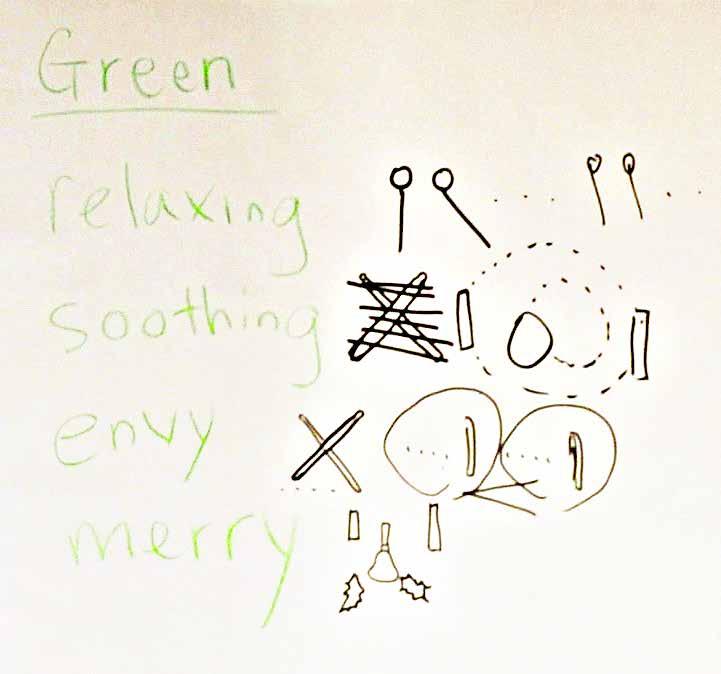
Moods associated with the colour green being translated to symbols, and which are then incorporated into a collectively drawn image
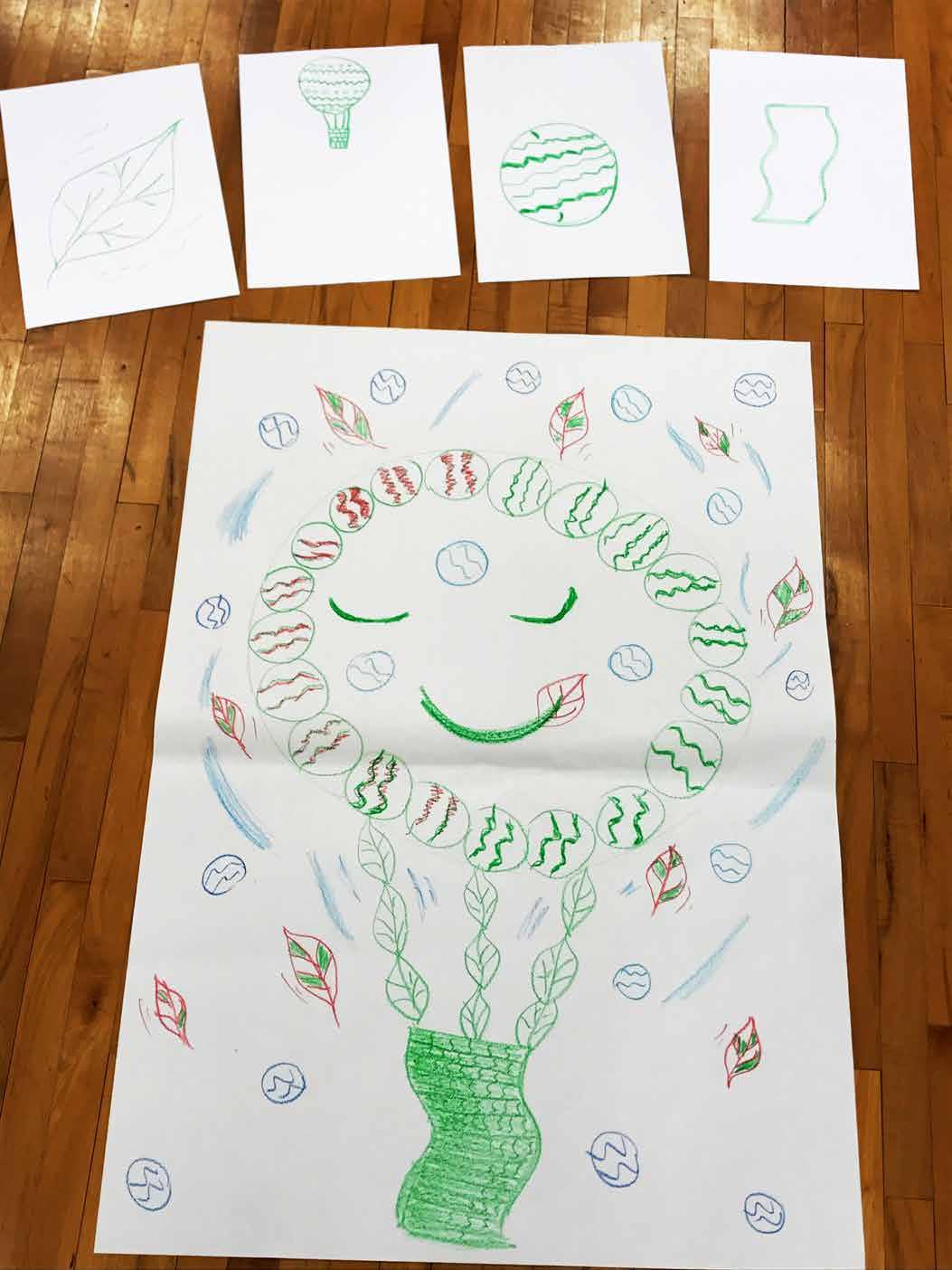
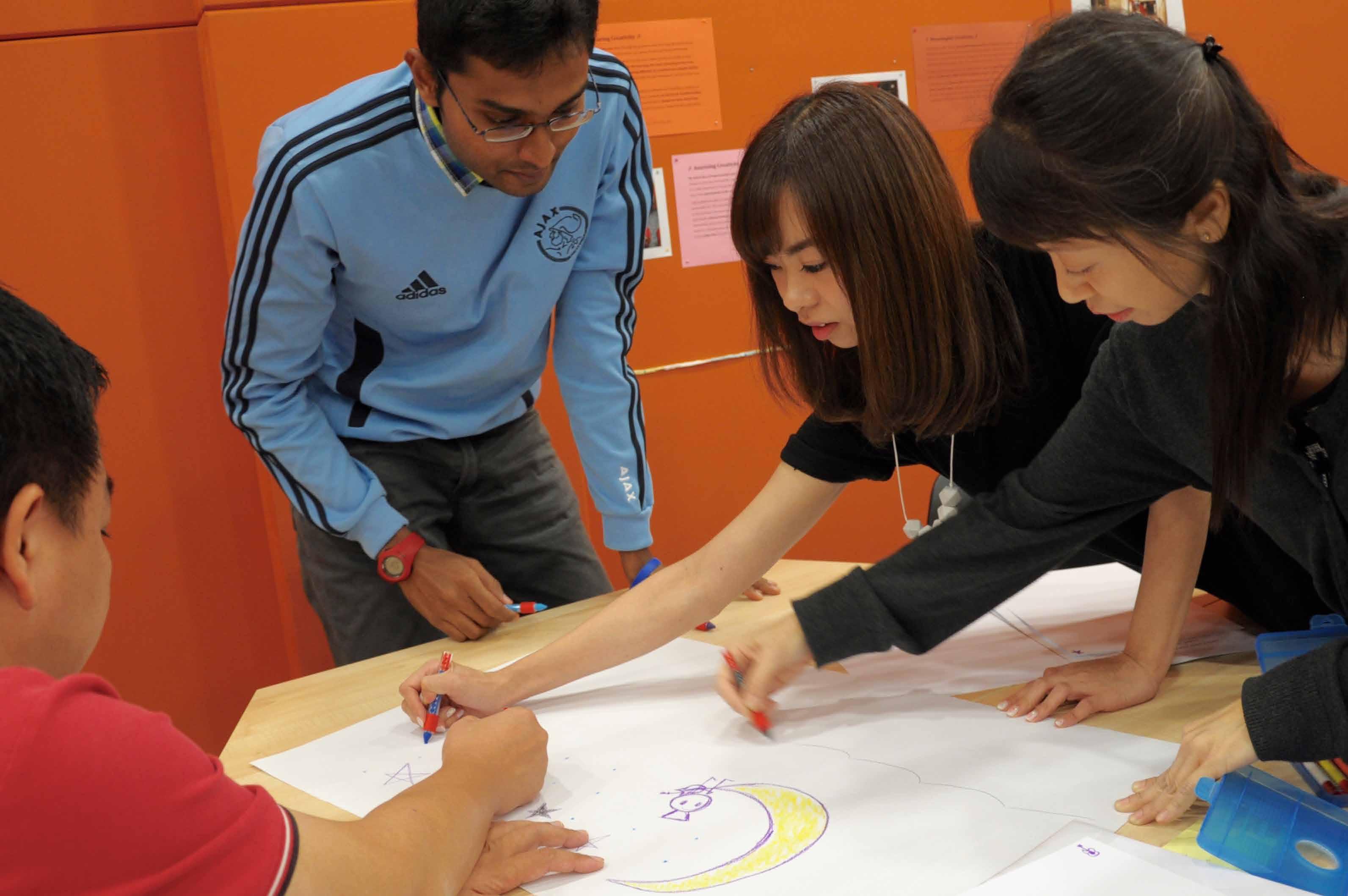
As the opening quote by Miles Davis suggests, there are no mistakes in improvisation. Composing and improvising are both powerful avenues of eliciting the students’ voice. As music teachers, when we pause and listen to their voices, and help them make sense of their musical thinking visually, they feel valued as music creators. And that’s a good step towards developing them as musicians.
Both the STAR champions (Pri and Sec) worked collaboratively as they shared their learning experiences not only within the STAR Champions workshop but also beyond, at the national level with the larger music fraternity.
Stories are universal and adaptive for all ages. A powerful tool to introduce the teaching of a new song as it engages the listener to imagine new perspectives in an empathetic manner. Stories gives background to the songs, and provides the context for students to respond to expressive elements in the music, allowing them to gain a deeper experience and appreciation of the song, thus making learning meaningful.
This was how Outstanding-Educator-In-Residence (OEIR) Kate Woolveridge introduced classical opera, specifically Toreador from Bizet’s Carmen during the Engaging With Songs (EWS) programme.
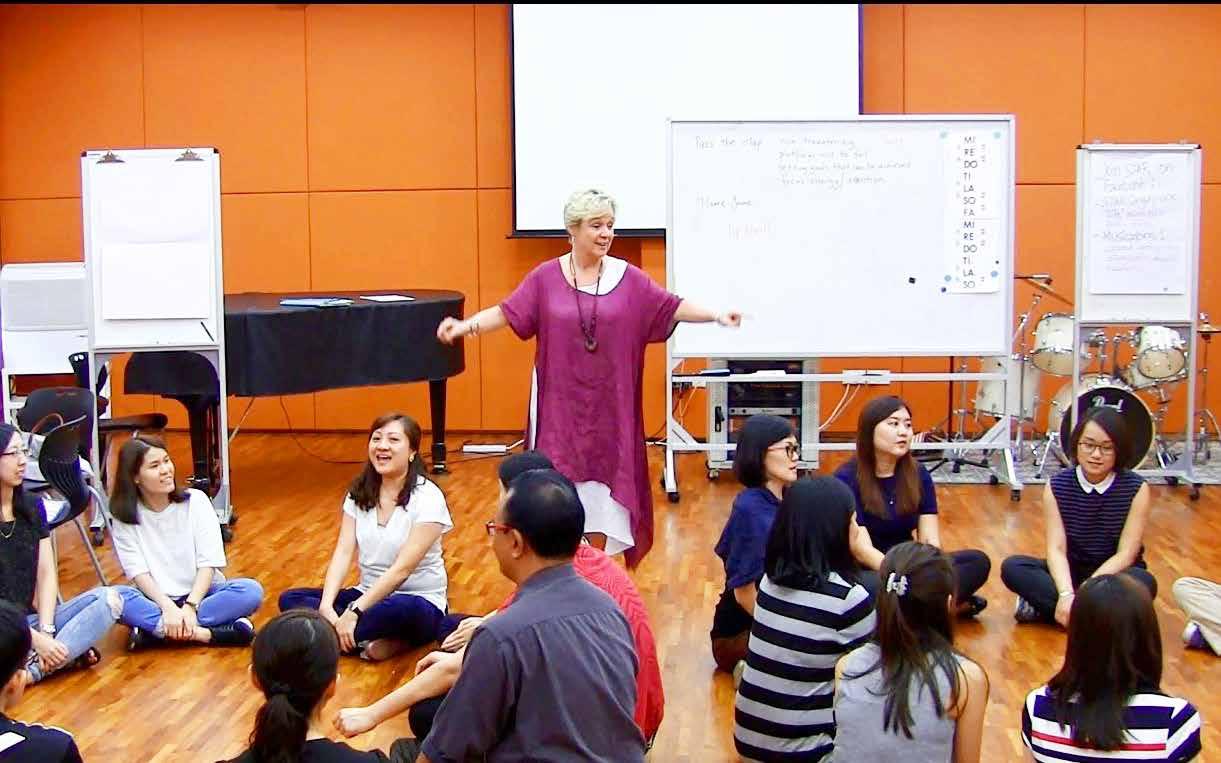
OEIR Kate Woolveridge engaging the teachers in singing
The storytelling journey drew on the senses and imagination of the teachers as Kate transported them to Spain. She likened the summer heat to the scorching weather of Singapore, to relate to the teachers’ lived experiences. As she unfolded the key characters in Carmen, she invited the teachers to rename one of the characters to involve them in the storytelling. This process considered students’ voice and increased relatedness. With interest drawn, Kate modelled the steps to learning the song. Before everyone knew it, they were singing in gusto and acting out the scene for the added dramatic element.
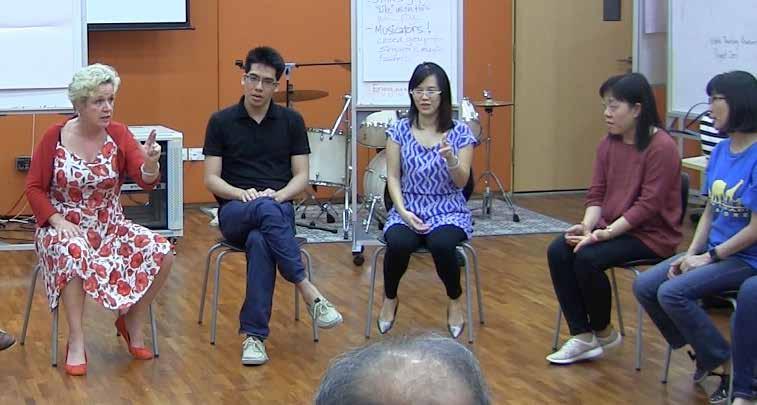
It was not simply singing but the clever use of a myriad of strategies to portray the mood of the lyrics. Some of these strategies include speech chanting to the rhythmic pattern of the melodic line, musical phrasing, and the use of body movements. These were made explicit during the unpacking by Master Teacher (Music), Mdm Suriati Suradi, in addition to its application to the music classroom.
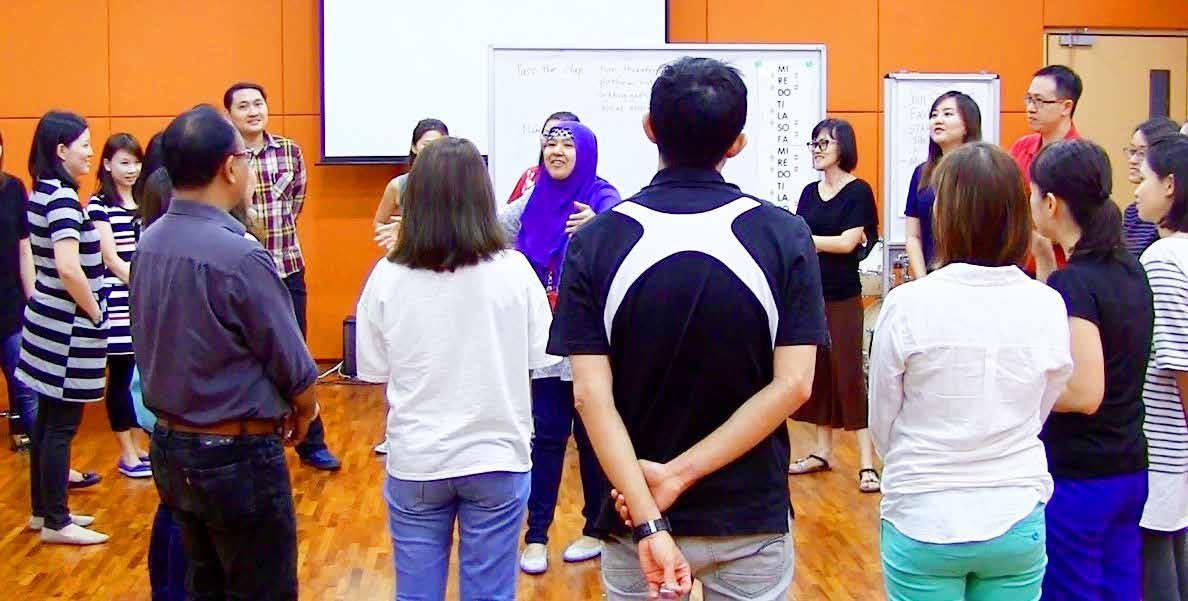
Stories and songs can also make for teachable moments. And with any good story, an added element of surprise can pique the interest of the learners.
Not giving away the title of the song at the start, OEIR Rinat Gilat Elfron introduced a simple melodious line in solfege. The teachers learnt the tune aurally and were quick to internalise it due to its repeating patterns. Only when the teachers were confident to perform on their own, did she overlay this tune with the melody of Blowing In The Wind. The teachers enjoyed the surprise, music-making and in the process, experienced the concept of countermelody and two-part singing.
The teachers had to actively listen for musical features to sharpen their aural perception for example, the number of repeated phrases, the highest or lowest note etc. The story behind the song was then shared; about its composer; the lyric; and about embracing the ups and down in the journey of life.
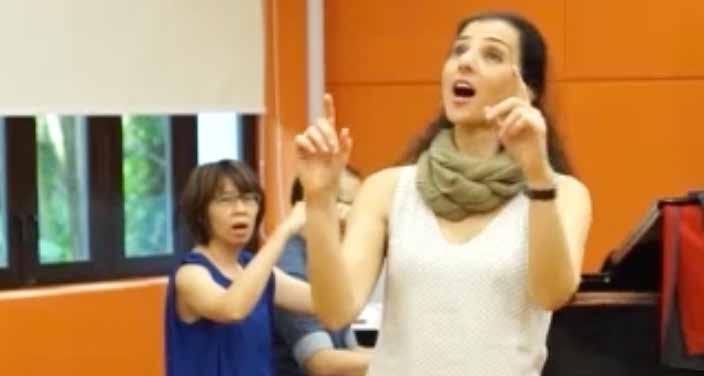
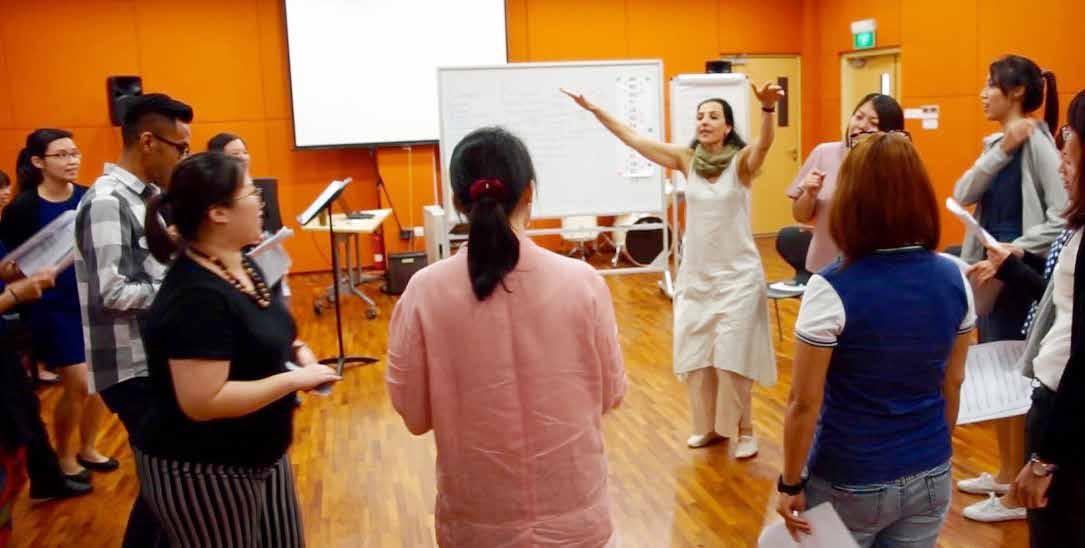
For the EWS teachers, the two sessions increased their repertoire of innovative strategies, and together with the MTT’s unpacking, provided teachers a deeper understanding of the broader pedagogical principles at work in teaching engaging and lively music lessons.
The Singapore Teaching Practice (STP) was launched in May this year. The STP makes explicit how effective learning and teaching is achieved in the Singapore classroom. It is a common knowledge base, shared frame of reference and common language for professional dialogue to achieve quality learning and teaching.
As part of the Singapore Teaching Practice, Pedagogical Practices (PP) describes what we think and do as teachers to bring about engaged learning. The four core Teaching Processes are at the heart of PP:

This is first of a three-part series on the Singapore Teaching Practice, to unpack the Teaching Processes and their corresponding Teaching Areas.
In this issue of STAR-Post (Music), we focus on how the Teaching Process “Positive Classroom Culture” can be built and facilitated in a music lesson.
• ESTABLISHING INTERACTION AND RAPPORT
• MAINTAINING POSITIVE DISCIPLINE
• SETTING EXPECTATIONS AND ROUTINES
• BUILDING TRUST
• EMPOWERING LEARNERS
Establishing interaction and rapport
is about setting up positive emotional connections between teachers and students, and between students in the learning environment. These enable students to feel respected, supported and valued.
Students and Teacher singing and playing music together facilitates interaction and rapport in a musical way.
Jackson 5 or Maroon 5
Being open and respecting of the music that your students enjoy. The music speaks about who they are, and respecting their musical preferences signals to them that they are valued as individuals.
Building and maintaining positive discipline creates an environment that is conducive for learning and developing self-discipline in students. It educates and guides students to internalise values and understand acceptable behaviour.
Setting clear expectations and routines for student behaviours are critical for good classroom management, effective instruction and lesson delivery.
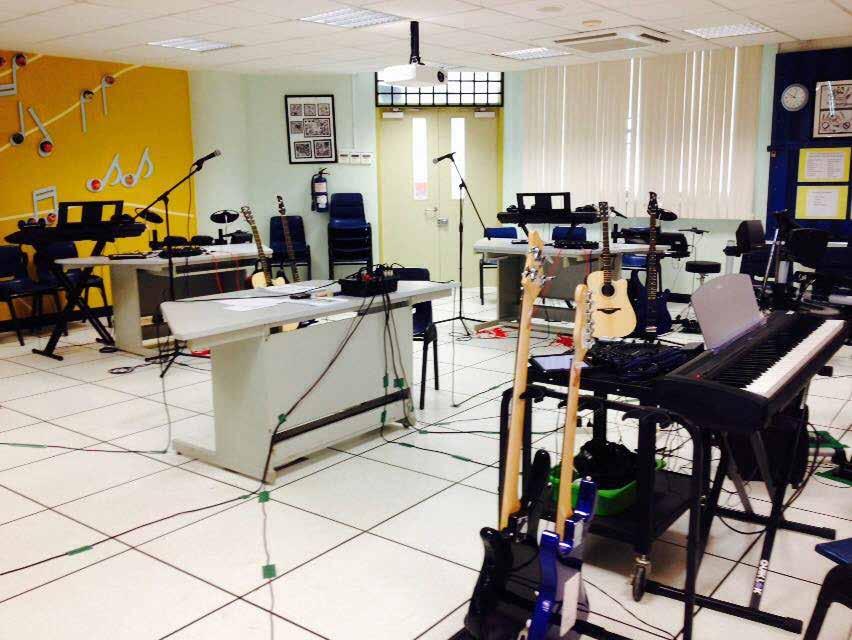
An organized classroom allows for routines to take place and creates a conducive environment for learning
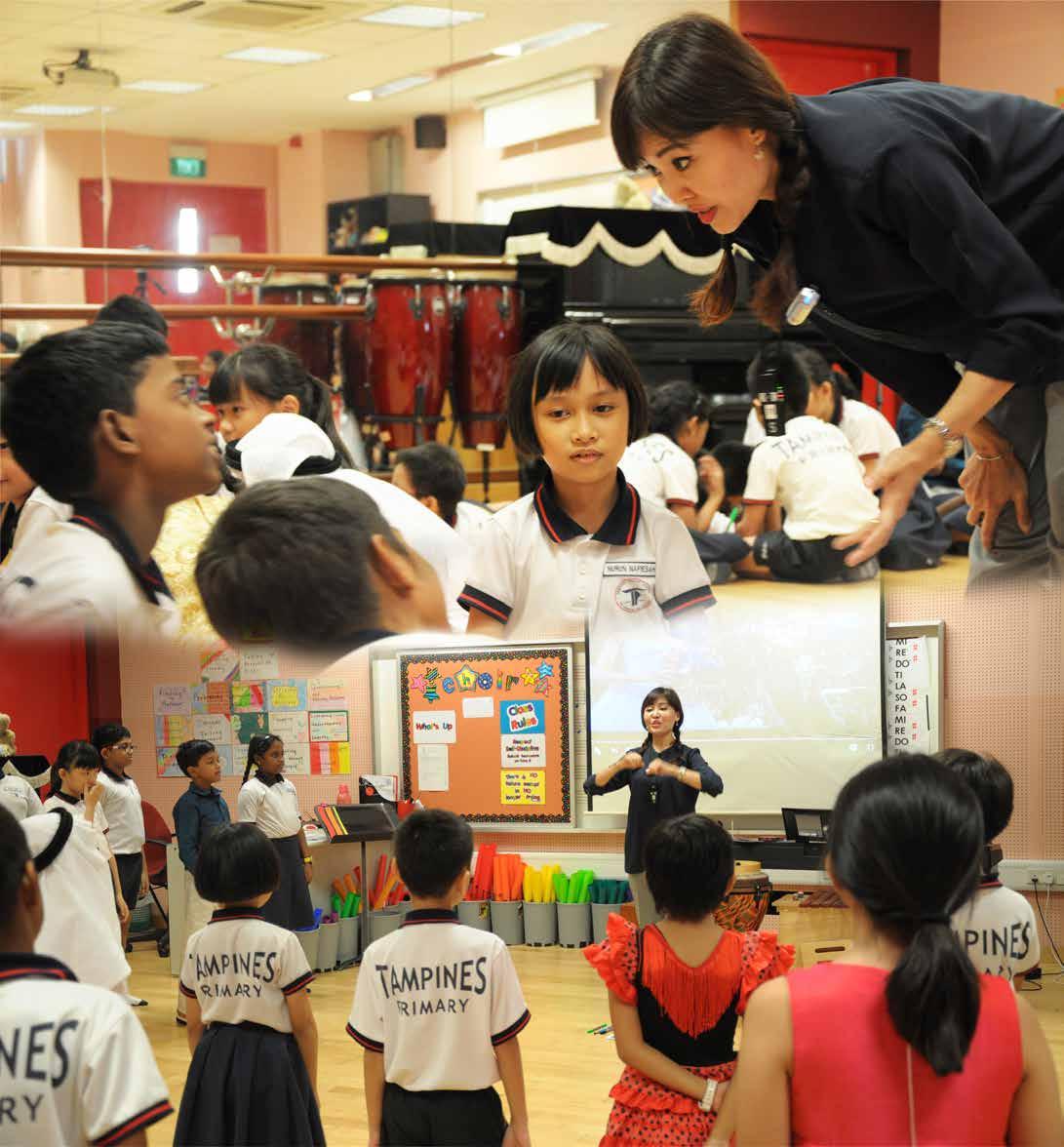
Explore and vary seating arrangements and room set ups for different musical activities
In the music classroom, teachers create musical routines to facilitate lesson transitions (e.g. changes in class formation to facilitate music making)
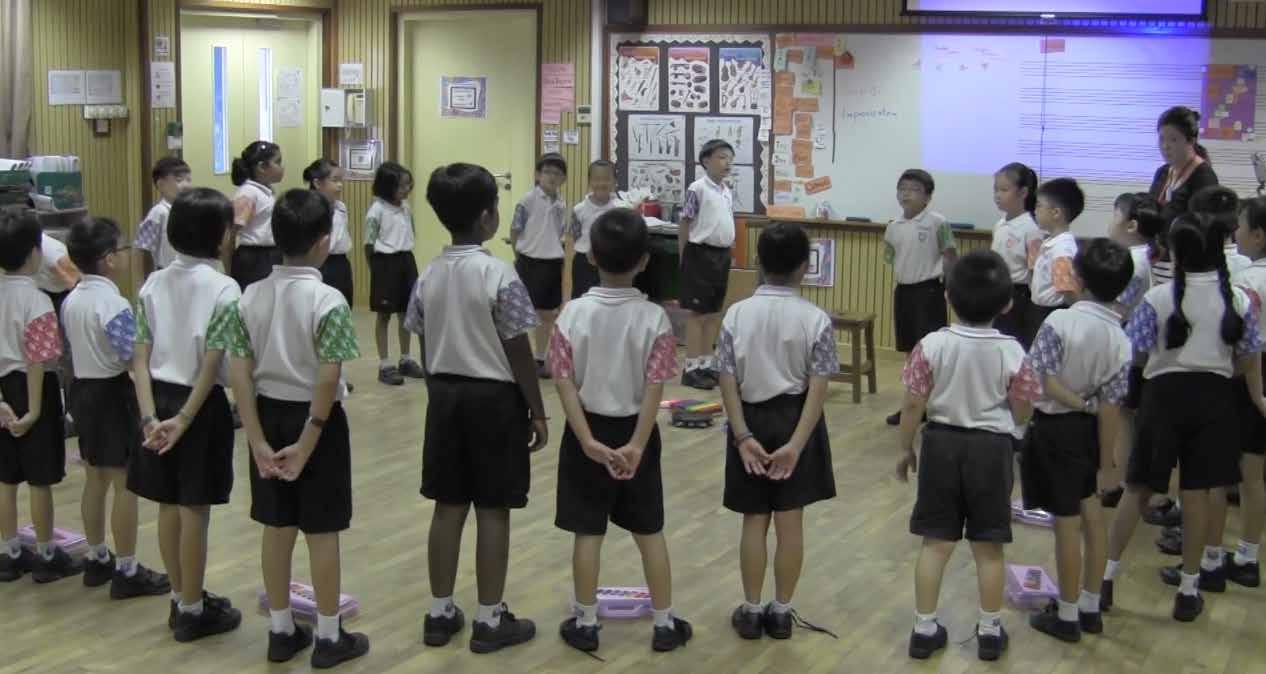
Musical Routine Click here!
View this video excerpt illustrating a routine for dismissing a music class which is demonstrated by Mdm Irene Chan from West Grove Primary School.
Building trust increases your credibility and authenticity as a teacher. Empowering learners is about enhancing the students’ ability to focus internally and take personal responsibility. The more the locus of control is internal, the more students will feel that they are accountable for their learning. In music classroom, this translates to providing autonomy for students to make musical decisions and even how they learn.
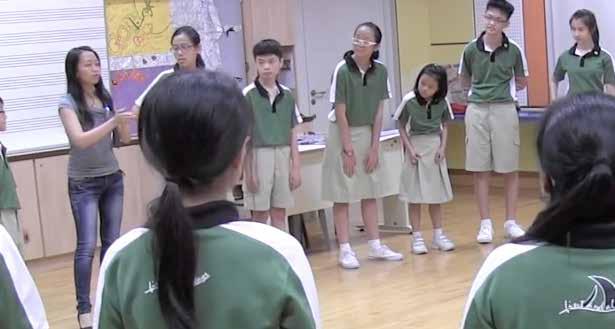
Giving Students’ Voice Click here!
View this video excerpt illustrating how Music teacher, Ms Leong Su Juen from Pasir Ris Secondary School empowered her students in their class routine warm-up.
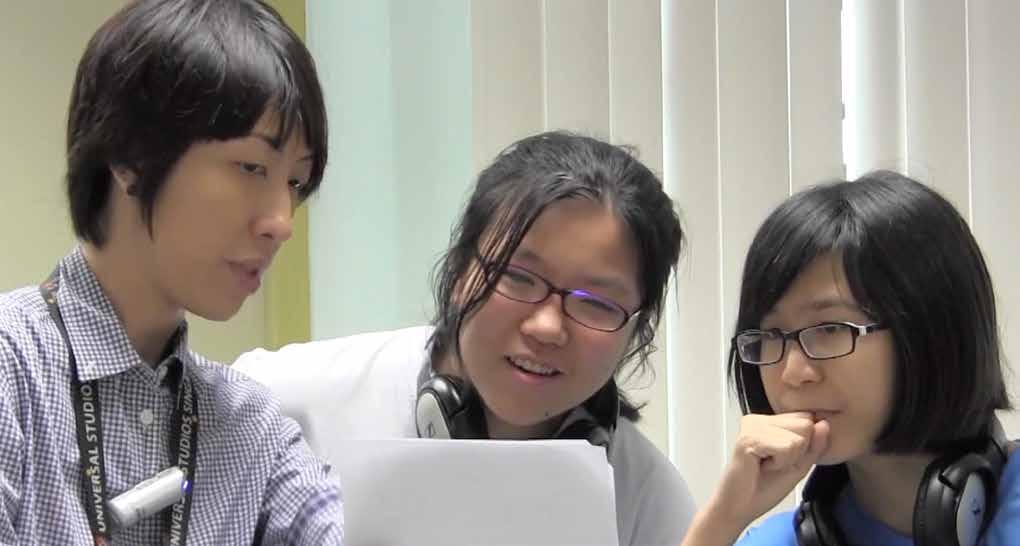
Empowering students in music decision making Click here!
View this excerpt illustrating how Ms Adeline Tan, former Subject Head (Aesthetics), Bishan Park Secondary School involved her students in music making.
“Passion for music” Ms Ng Kay Gek, Senior Teacher, Music, was what spurred her major career decision to take on a new subject specialisation. She shares how she felt supported by the professional development made available to Music teachers in her transition from a generalist teacher.
Fuelled also by her strong beliefs for arts education, Kay Gek up-skilled herself by taking up the Advanced Diploma in Primary Music Education, offered by National Institute of Education in 2012. Her lifechanging decision also pathed her naturally towards her progression and subsequent appointment as a teacher-leader.
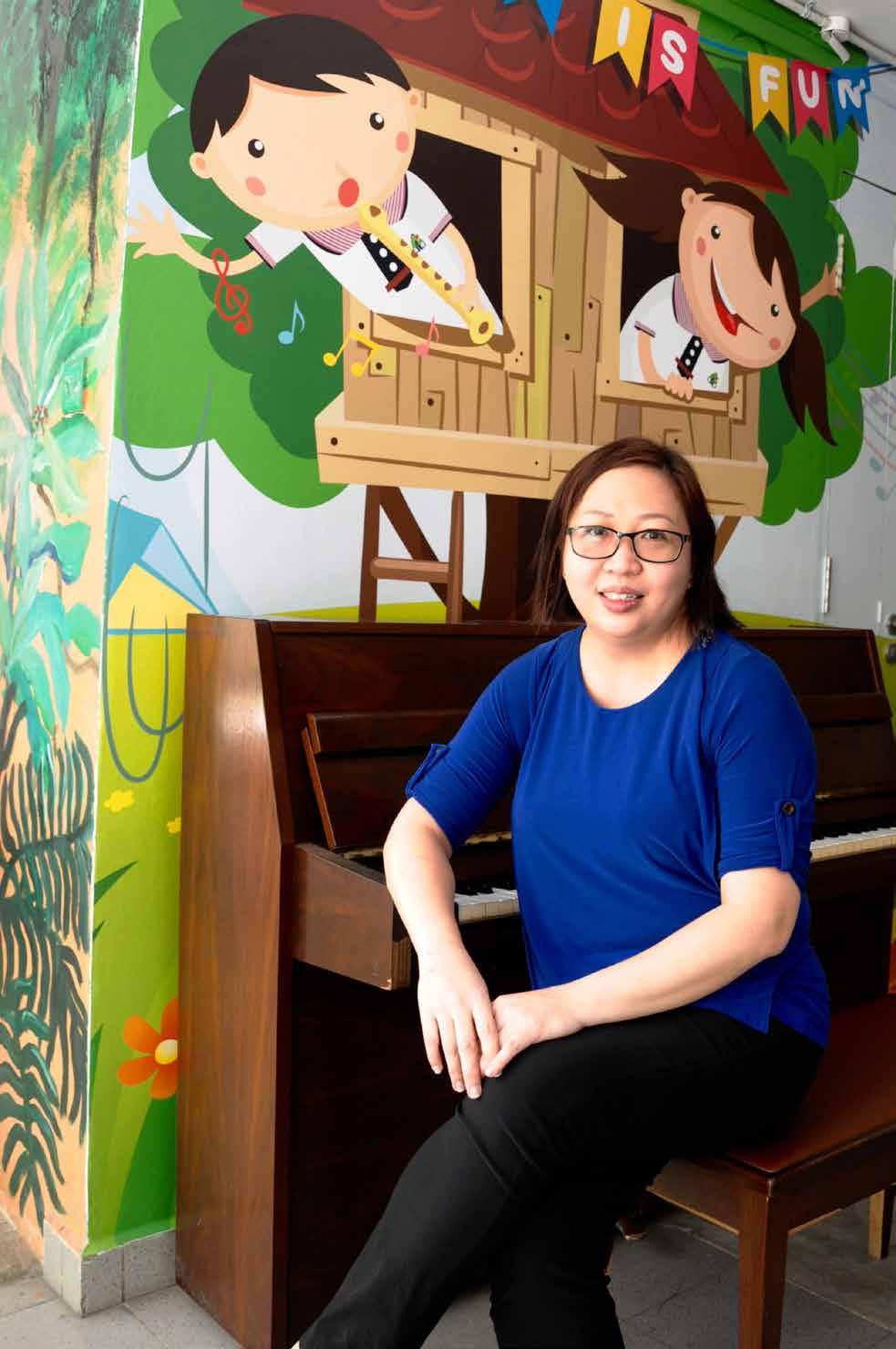
Kay Gek stressed the importance of continual professional development which helped expand her repertoire of teaching strategies and renewed her perspectives towards music education.
Being a part of the Engaging with Songs (EWS) programme since 2015, Kay Gek recounted inspirational nuggets she learnt which transformed her teaching practice. She cited Kate Woolveridge, who impressed on her the use of dramatisation and games to teach songs and singing in a fun and engaging manner.
“Singing Games!” was Kay Gek’s unreserved response to the key learning she gleaned from EWS.
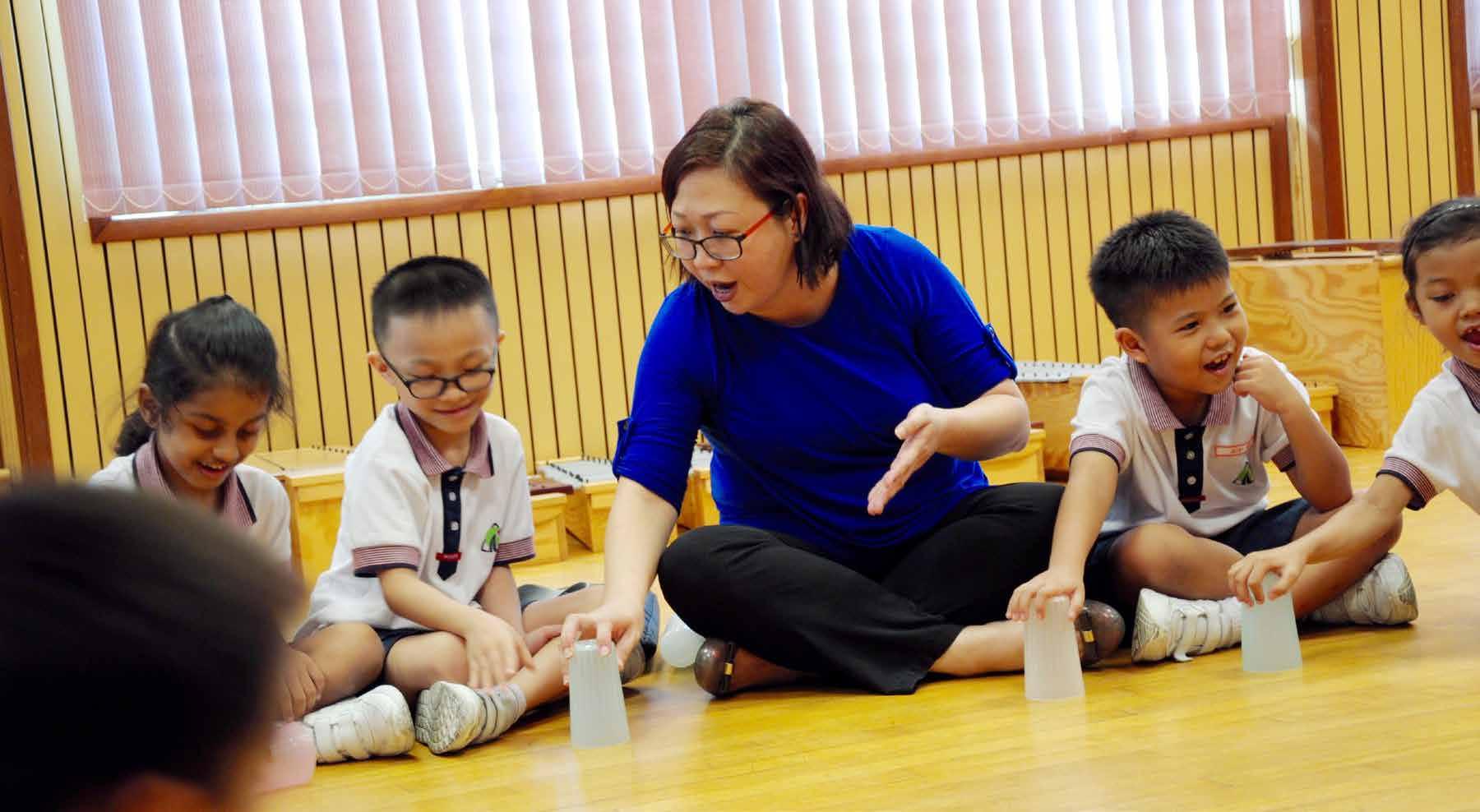
Singing Games are more than just games involving singing, nor are they time-fillers. They are specific to teach music learning objectives; to experience music concepts through singing, connecting with an element of play and/or challenge.
Picture 2_A Musical Conversation_Students Singing while engaged
Caption: Students singing while engaged in fun and games
We all know that children love playing games.
When games are infused in musical play, learning happens subconsciously. Games thus offer
easy access to learning by giving students choices while developing positive attitudes. It presents opportunities for building self-concept and cooperative learning by reducing the fear of failure and error. With increased student interactions and creative explorations, students are given the opportunities to develop social emotional skills. More importantly, it is the joy of learning that singing games bring to the learners.
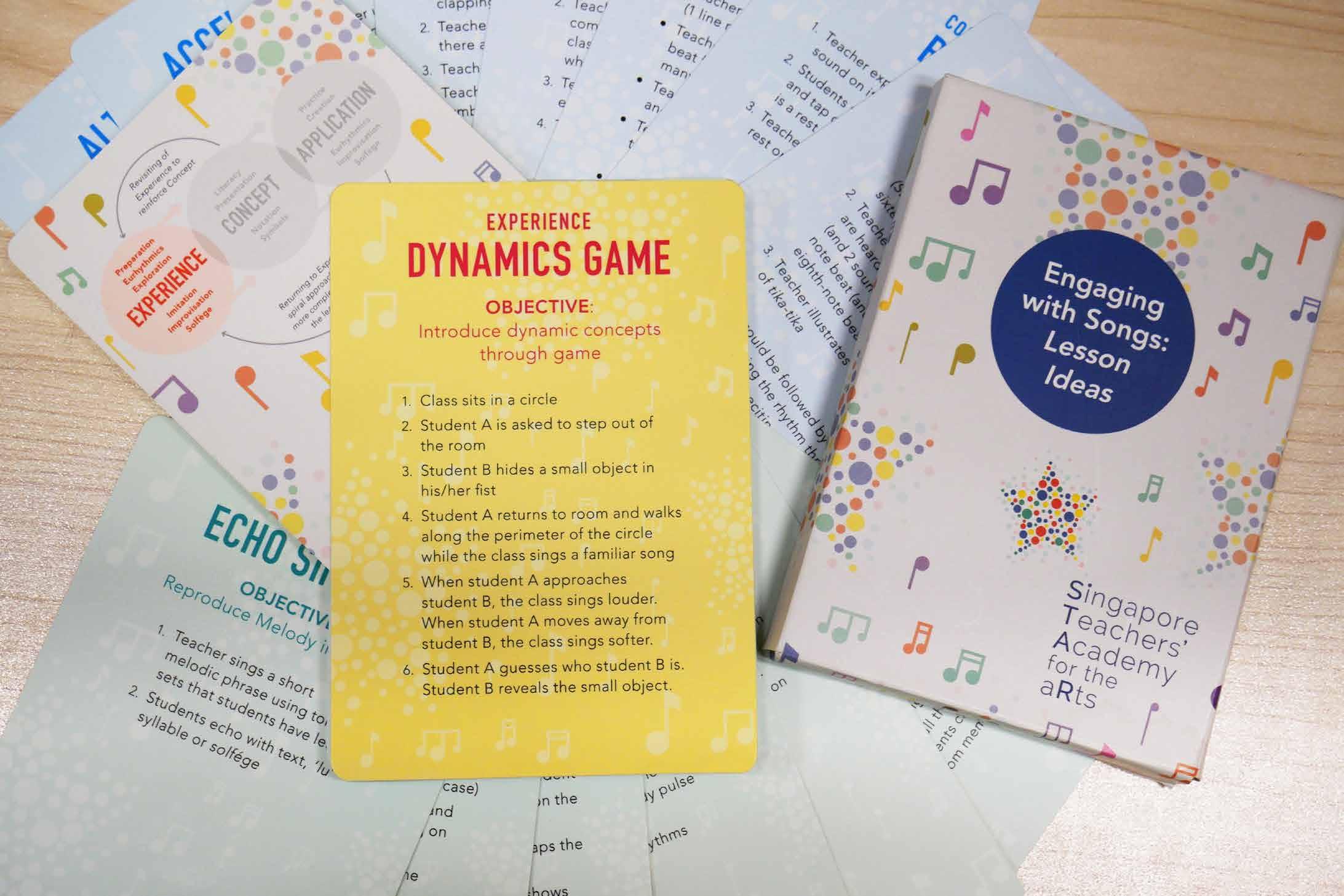
Try the Dynamics Game with your students –a musical version of ‘hide-andseek’.
A chosen student has to find an object hidden among his classmates. The class hints at his/ her proximity to the hidden object through the use of dynamics while singing the accompanying song. For example, the class would sing louder as the student gets nearer or softer when moving further away from the concealed item.
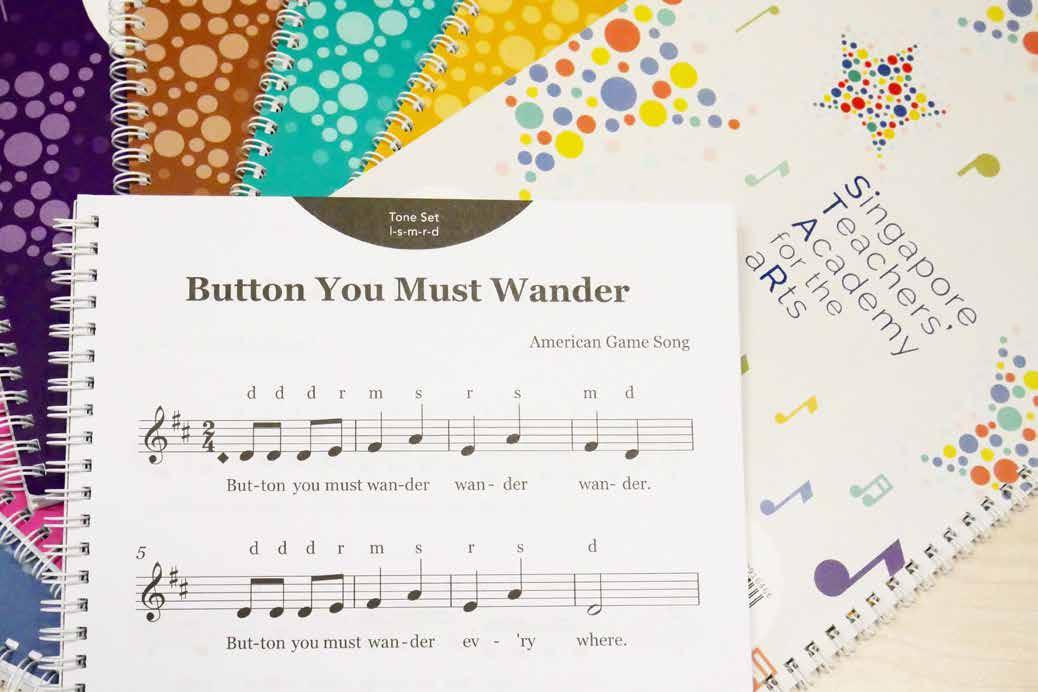
Singing games play a significant part in Kay Gek’s music lessons. She shared that the element of surprise and sense of anticipation motivated students to keep on track.
She highlighted the need to scaffold various segments of the lesson to facilitate student learning to make connections between experience and concepts. Warming up the voices while setting the context of the song aids a seamless learning experience that is fun and enjoyable.
Another key insight from Kay Gek’s professional learning was how music teaching integrates listening, performing and creating, and these components should not be treated as isolated activities. For example, rather than solely focusing on learning to play a piece of music on the recorder, Kay Gek suggested to begin with fun and imaginative breathing exercises as warm ups, followed by first singing to internalise the melody before playing it on the recorder. Finally the class performs the piece collaboratively, combining singing and instrumental playing.
Invite students to imagine taking a walk in a beautiful garden, filled with blooming flowers. As they walked, they stopped occasionally to take in deep breaths of sweet-smelling flowers. .
The objective of this warm up is to relax the body after long periods of sitting, and to engage in breathing exercises for singing songs about flowers.
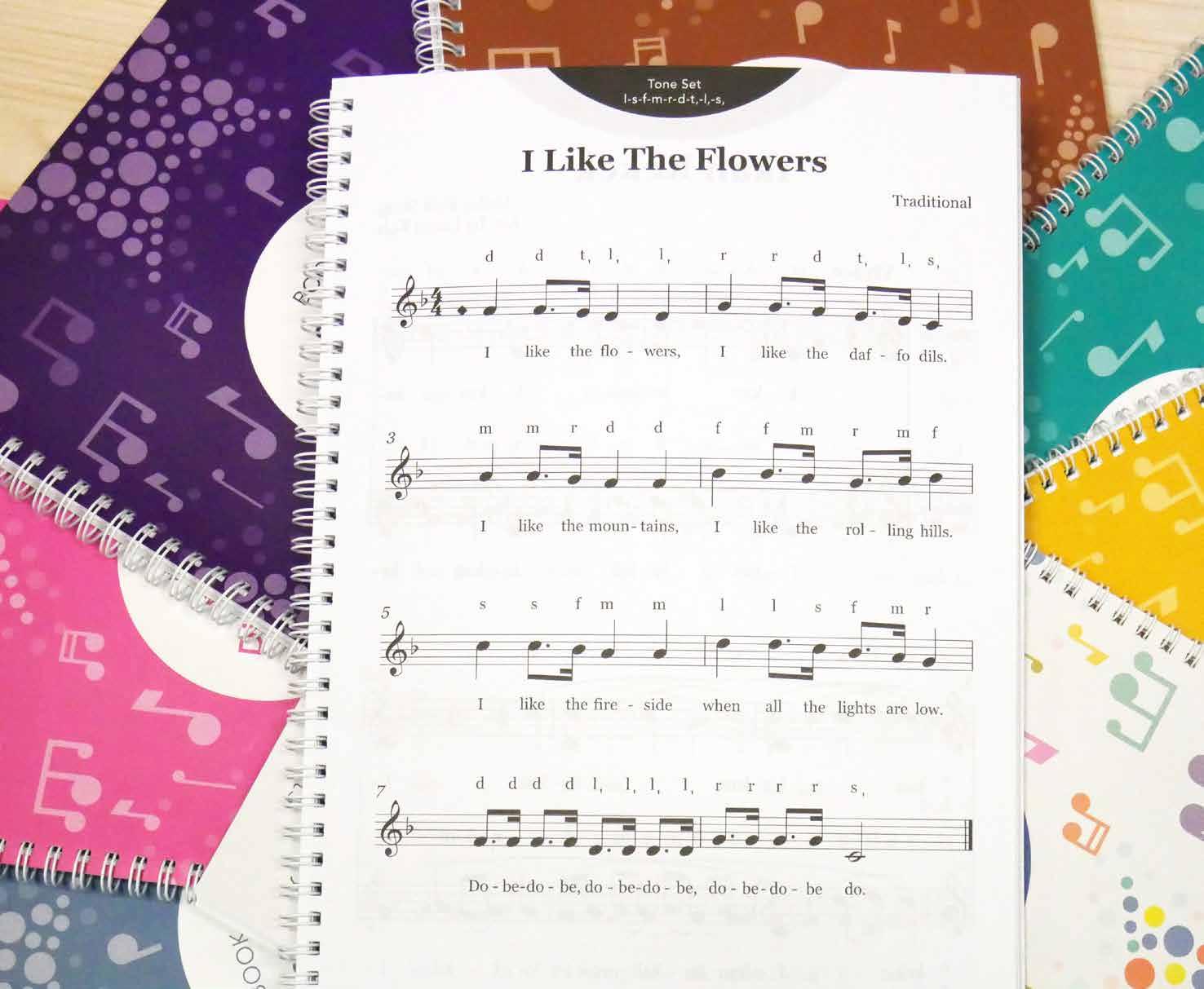
Kay Gek firmly holds true to her belief that music teaching is more than just the classroom curriculum; music should be in the daily lives of every student –experienced naturally as part of the holistic education one receives in primary school.
In Angsanna Primary School, students enjoy weekly “Just Sing Wednesday” during pre-assembly, where both students and teachers experience the joy of singing as a community. Where singing was an occasion not shared as an assembly, Kay Gek has found transformative solutions that a collective experience can be shared. Learning becomes a habit of mind, an expectation that the experience is understood in other learning contexts beyond the confines of a taught class period.
The song repertoire, taught during music lessons, is specially curated to tie in with key events in school and the larger community. For example, in anticipation of celebrating Earth Day, Kay Gek incorporated ‘I am the Earth’ by Glyn Lehmann in her music lessons, preparing the students for community singing while imparting values that encourage her young charges to be environmental stewards.
‘One shouldn’t stop playing and making music.... Music bonds people’
A former band member, Kay Gek strongly believes in the value of discipline, commitment and playing music in a community. To stay in touch with her musical practice, she recently started lessons on the Guzheng.
Kay Gek could not stress more that improving one’s music teaching is a continual journey. She humbly shared that being a Senior Teacher, does not mean that she has ‘arrived’. “We should constantly ask ourselves how to do (and teach) better.”
She strongly recommends networking and partnering with fellow music teachers; it is the very collaborative process which brings forth innovation, creativity, and critical inquiry to build the pedagogical knowledge of the music teaching fraternity.
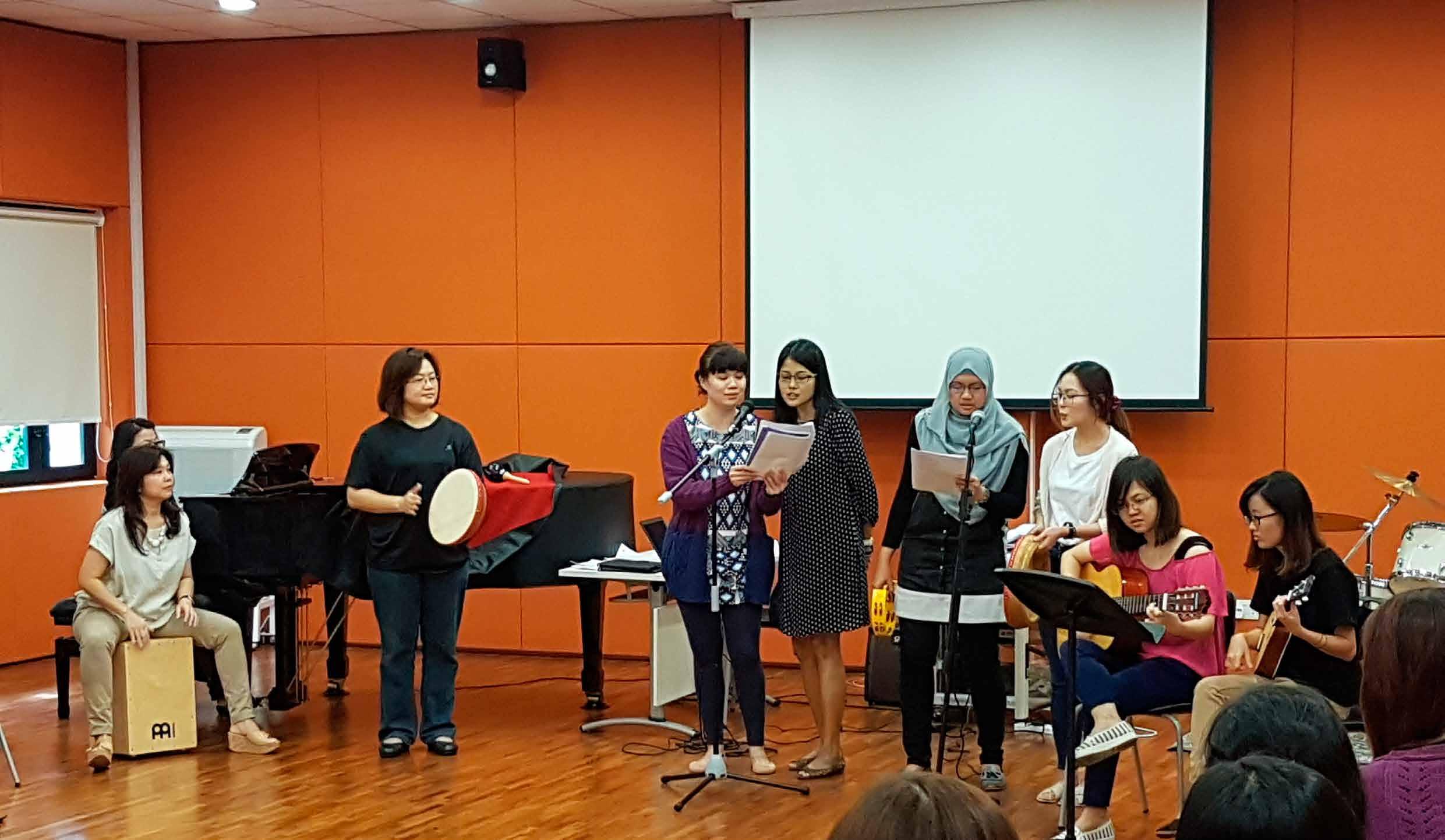
Music teachers exploring Singapore music traditions as part of STAR’s Teaching Living Legends milestone programme
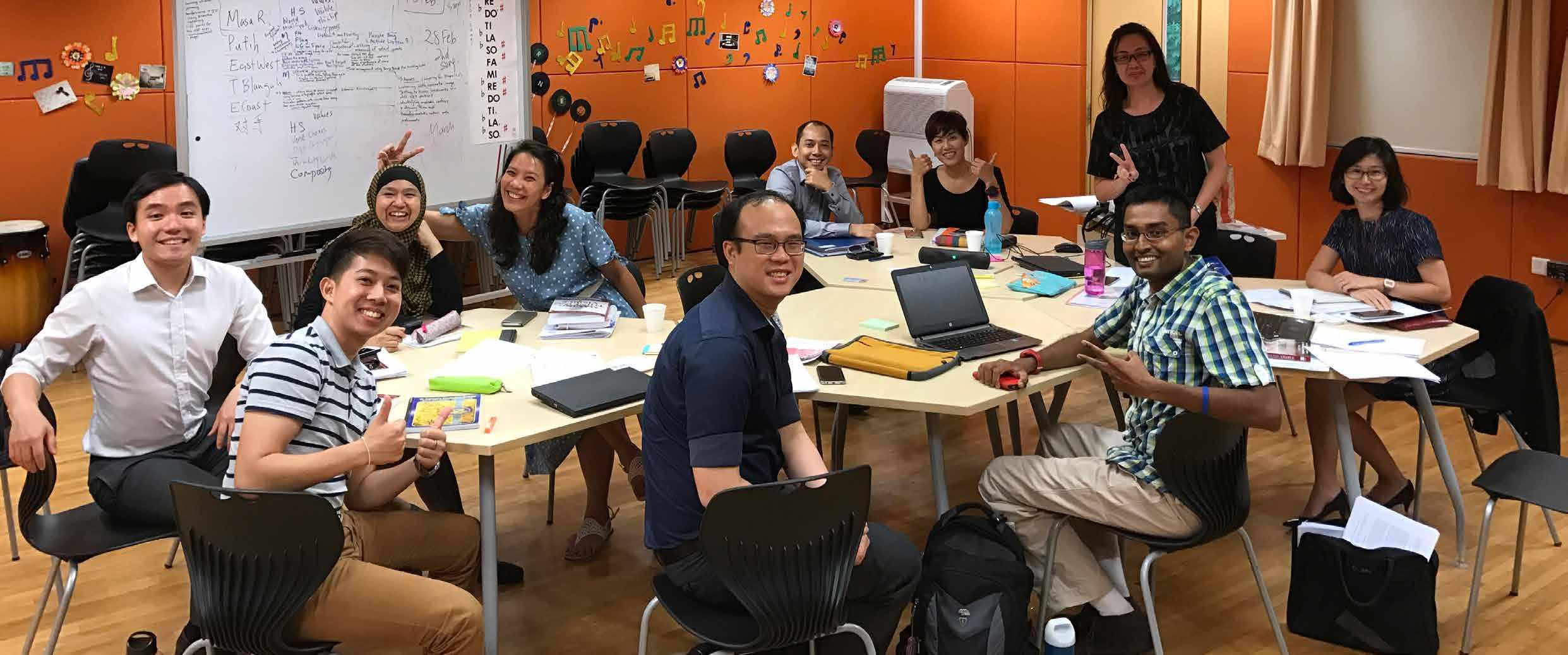
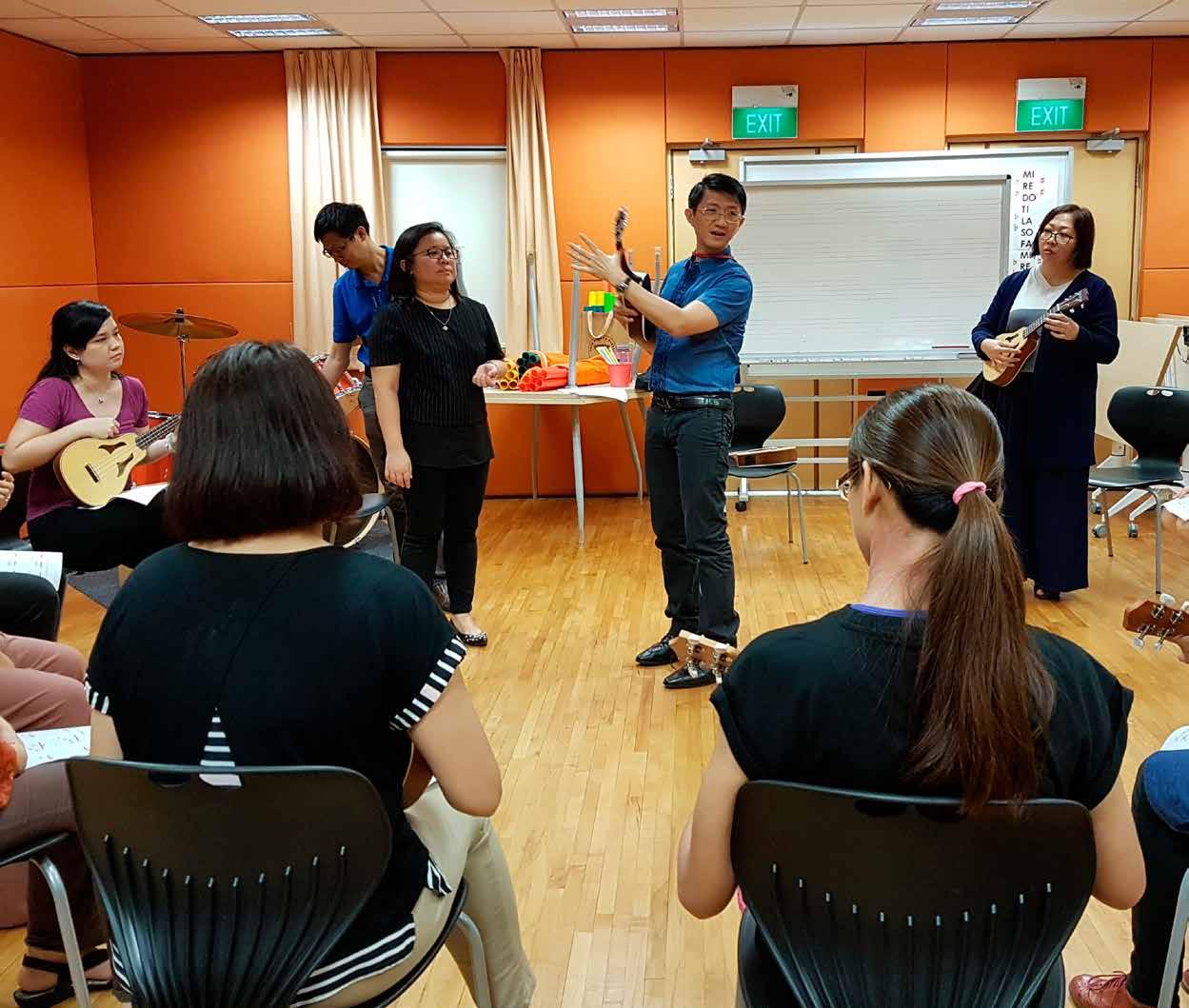
Teacher Leaders modeling lesson strategies for primary school generalist music teachers
Music teachers and Master Teachers co-designing studentcentric lessons in a Pedagogical Song Networked Learning Community
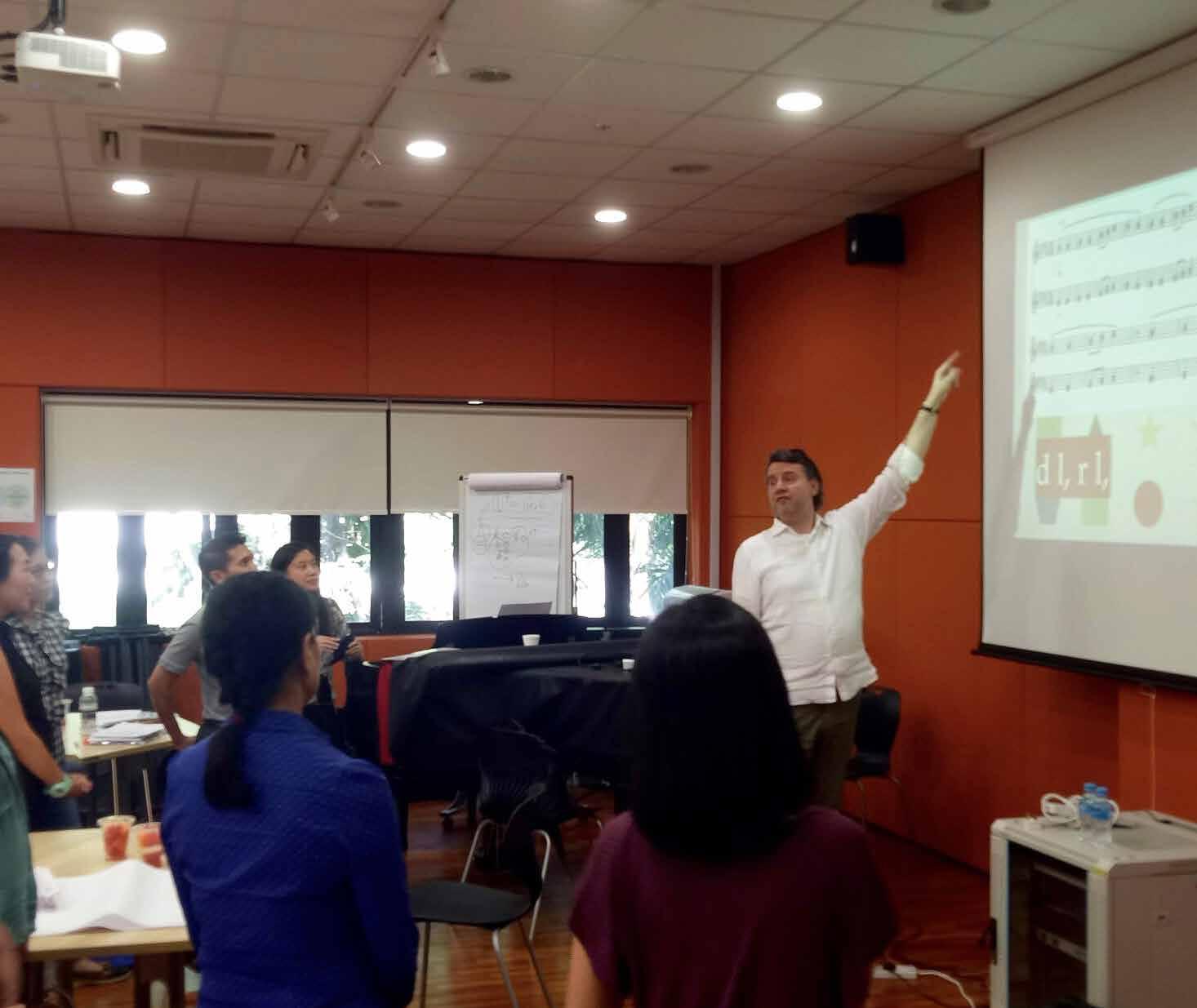
Music Teachers gaining fresh insights to teaching ‘O’ and ‘A’ level Music Studies through the lens of Kodály Approach by OEIR, László Nemes
Creative musical expression through
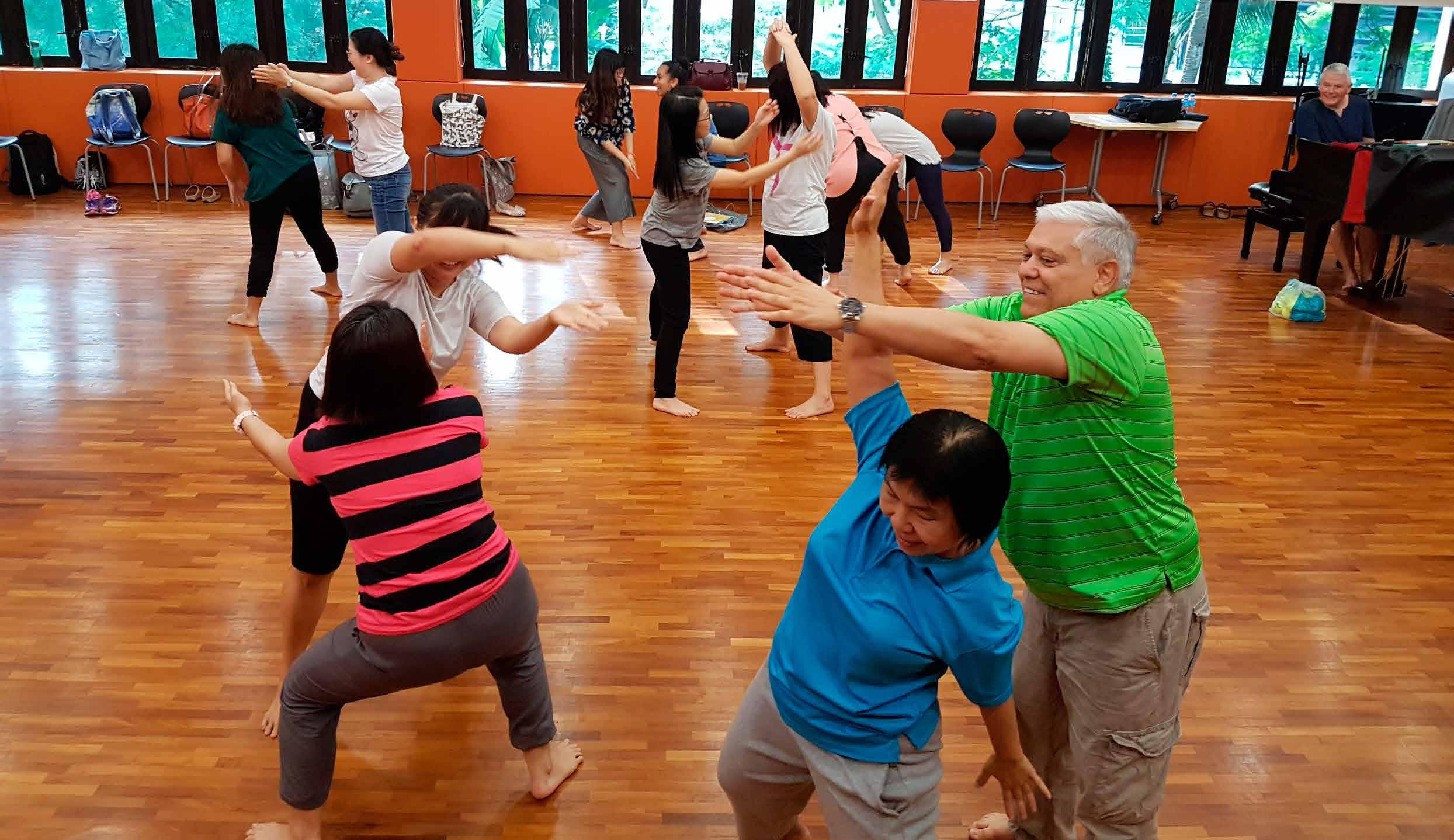
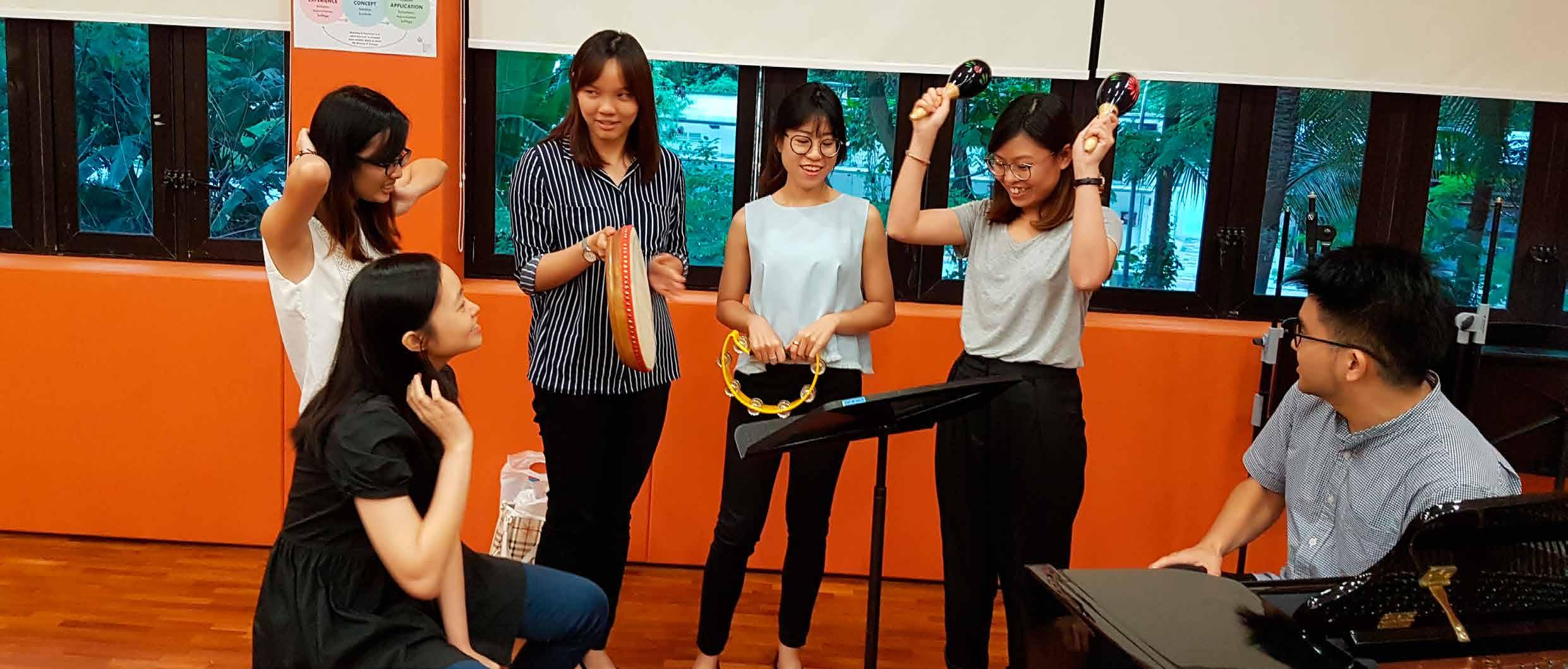
Beginning Music Teachers engaging in collaborative music making
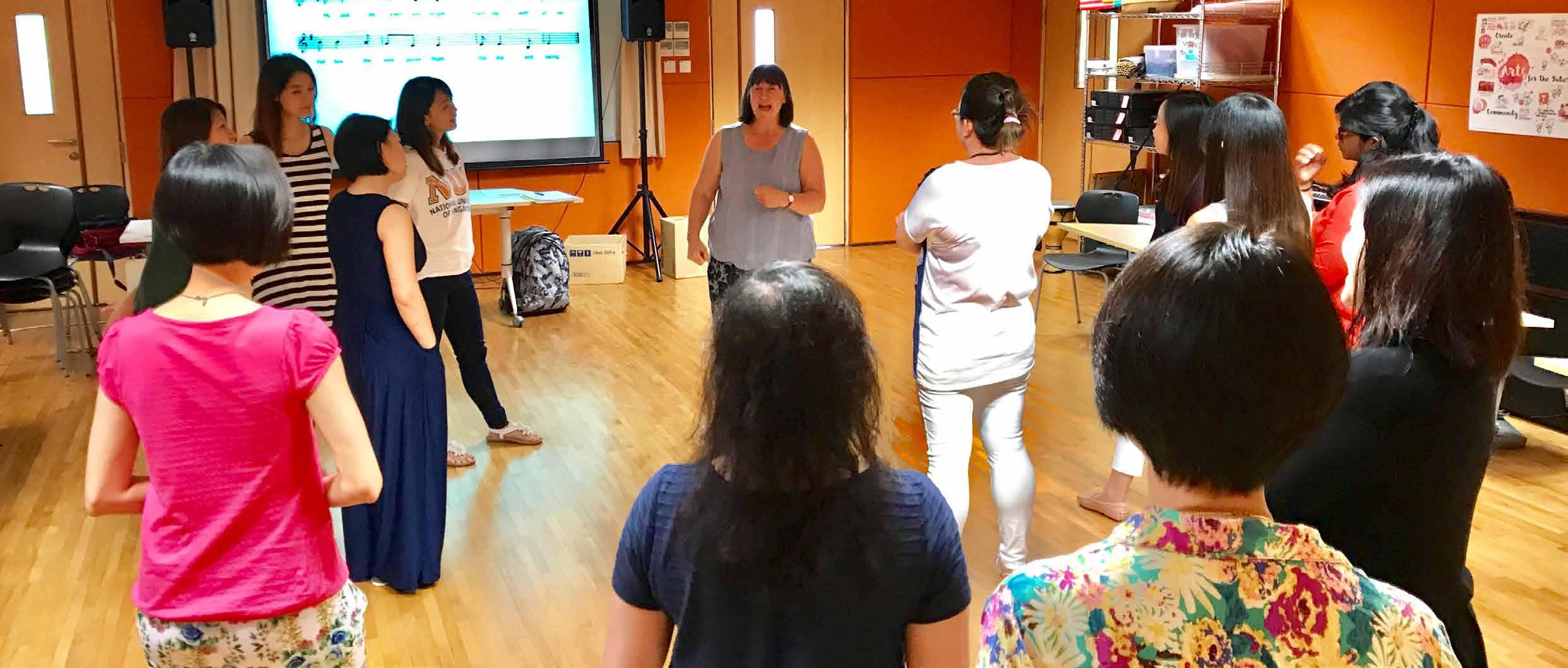
Cultivating musicianship through

Ho Hui Ping
Deputy Director (Music)
HO_Hui_Ping@moe.gov.sg
+65 6664 1493
Tan-Chua Siew Ling
Master Teacher (Music)
CHUA_Siew_Ling@moe.gov.sg
+65 6664 1554
Li Yen See Master Teacher (Music)
Chan_Yen_See@moe.gov.sg
+65 6664 1499
Suriati Bte Suradi
Master Teacher (Music)
Suriati_SURADI@moe.gov.sg
+65 6664 1498
Kelly Tang
Senior Academy Officer (Music)
Kelly_TANG@moe.gov.sg
+65 6664 1561
Leong Siew Chun
Senior Academy Officer (Music)
LEONG_Siew_Chun@moe.gov.sg
+65 6664 1495
Tan Li Jen Adeline
Senior Academy Officer (Music)
Adeline_TAN@moe.gov.sg
+65 6664 1494
Desmond Seah Academy Officer (Music)
Desmond_SEAH@moe.gov.sg
+65 6664 1555